Methods and uncertainties in bioclimatic envelope modelling under climate change
- 格式:pdf
- 大小:354.02 KB
- 文档页数:27
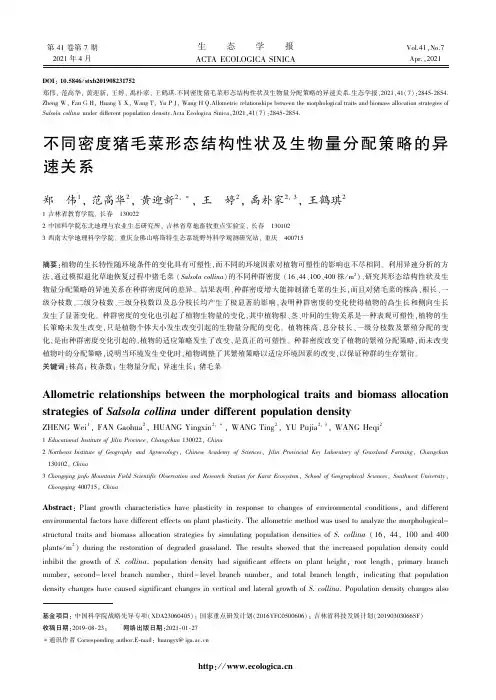
第41卷第7期2021年4月生态学报ACTAECOLOGICASINICAVol.41,No.7Apr.,2021基金项目:中国科学院战略先导专项(XDA23060405);国家重点研发计划(2016YFC0500606);吉林省科技发展计划(20190303066SF)收稿日期:2019⁃08⁃23;㊀㊀网络出版日期:2021⁃01⁃27∗通讯作者Correspondingauthor.E⁃mail:huangyx@iga.ac.cnDOI:10.5846/stxb201908231752郑伟,范高华,黄迎新,王婷,禹朴家,王鹤琪.不同密度猪毛菜形态结构性状及生物量分配策略的异速关系.生态学报,2021,41(7):2845⁃2854.ZhengW,FanGH,HuangYX,WangT,YuPJ,WangHQ.AllometricrelationshipsbetweenthemorphologicaltraitsandbiomassallocationstrategiesofSalsolacollinaunderdifferentpopulationdensity.ActaEcologicaSinica,2021,41(7):2845⁃2854.不同密度猪毛菜形态结构性状及生物量分配策略的异速关系郑㊀伟1,范高华2,黄迎新2,∗,王㊀婷2,禹朴家2,3,王鹤琪21吉林省教育学院,长春㊀1300222中国科学院东北地理与农业生态研究所,吉林省草地畜牧重点实验室,长春㊀1301023西南大学地理科学学院,重庆金佛山喀斯特生态系统野外科学观测研究站,重庆㊀400715摘要:植物的生长特性随环境条件的变化具有可塑性,而不同的环境因素对植物可塑性的影响也不尽相同㊂利用异速分析的方法,通过模拟退化草地恢复过程中猪毛菜(Salsolacollina)的不同种群密度(16㊁44㊁100㊁400株/m2),研究其形态结构性状及生物量分配策略的异速关系在种群密度间的差异㊂结果表明,种群密度增大能抑制猪毛菜的生长,而且对猪毛菜的株高㊁根长㊁一级分枝数㊁二级分枝数㊁三级分枝数以及总分枝长均产生了极显著的影响,表明种群密度的变化使得植物的高生长和侧向生长发生了显著变化㊂种群密度的变化也引起了植物生物量的变化,其中植物根㊁茎㊁叶间的生物关系是一种表观可塑性,植物的生长策略未发生改变,只是植物个体大小发生改变引起的生物量分配的变化㊂植物株高㊁总分枝长㊁一级分枝数及繁殖分配的变化,是由种群密度变化引起的,植物的适应策略发生了改变,是真正的可塑性㊂种群密度改变了植物的繁殖分配策略,而未改变植物叶的分配策略,说明当环境发生变化时,植物调整了其繁殖策略以适应环境因素的改变,以保证种群的生存繁衍㊂关键词:株高;枝条数;生物量分配;异速生长;猪毛菜AllometricrelationshipsbetweenthemorphologicaltraitsandbiomassallocationstrategiesofSalsolacollinaunderdifferentpopulationdensityZHENGWei1,FANGaohua2,HUANGYingxin2,∗,WANGTing2,YUPujia2,3,WANGHeqi21EducationalInstituteofJilinProvince,Changchun130022,China2NortheastInstituteofGeographyandAgroecology,ChineseAcademyofSciences,JilinProvincialKeyLaboratoryofGrasslandFarming,Changchun130102,China3ChongqingjinfoMountainFieldScientificObservationandResearchStationforKarstEcosystem,SchoolofGeographicalSciences,SouthwestUniversity,Chongqing400715,ChinaAbstract:Plantgrowthcharacteristicshaveplasticityinresponsetochangesofenvironmentalconditions,anddifferentenvironmentalfactorshavedifferenteffectsonplantplasticity.Theallometricmethodwasusedtoanalyzethemorphological-structuraltraitsandbiomassallocationstrategiesbysimulatingpopulationdensitiesofS.collina(16,44,100and400plants/m2)duringtherestorationofdegradedgrassland.TheresultsshowedthattheincreasedpopulationdensitycouldinhibitthegrowthofS.collina.populationdensityhadsignificanteffectsonplantheight,rootlength,primarybranchnumber,second-levelbranchnumber,third-levelbranchnumber,andtotalbranchlength,indicatingthatpopulationdensitychangeshavecausedsignificantchangesinverticalandlateralgrowthofS.collina.Populationdensitychangesalso6482㊀生㊀态㊀学㊀报㊀㊀㊀41卷㊀influencedonthebiomassofplant.Thebiologicalrelationshipsbetweenroots,stems,andleavesarean apparentplasticity ,andthegrowthstrategyhasnotchangedatall,onlythevariationofbiomassallocationwerecausedbythechangeofindividualplantsize.Changesinplantheight,totalbranchlength,primarybranchnumberandreproductivebiomassallocationweresignificantlyinfluencedbypopulationdensity,representing true plasticity.Theresultsshowedthatvariationofpopulationdensitycausedthestrategychangeofthereproductiveallocationratherthantheleafallocation,indicatingthatwhenenvironmentchanges,plantwouldadjustthereproductivestrategytoadapttosurroundingenvironmentalfactors,toensurethesurvivalandreproductionofthepopulation.KeyWords:plantheight;branchnumber;biomassallocation;allometricgrowth;Salsolacollina植物的形态结构特征及生物量分配策略是植物内在的发育过程适应所在环境条件的结果,当植物向各个器官分配其捕获的资源时,除了自身的遗传发育规律外,主要取决于包括生物因素和非生物因素在内的环境因素的变化[1]㊂其中,植物响应种群密度所产生的变化一直是生态学领域中的一个重要研究内容[2]㊂针对植物响应种群密度在内的环境因素变异所产生的变化这一研究内容,生态学家提出了最优化分配理论,认为植物倾向于将资源分配到能够获取最受限制资源的器官[3],然而这一理论也受到了挑战[4⁃5]㊂因为最优化分配理论的基础建立在植物生物量的分配是不依赖于个体大小的,但很多研究表明,在实际生长过程中,植物生物量的分配是受个体大小制约的[6⁃7]㊂因此如果只用最优化分配理论分析植物生物量分配的变化规律,则不能分辨植物形态结构性状及生物量分配的变化是由环境因素引起的,还是由个体大小原因导致的;而异速生长理论对解决这一问题具有重大意义[8⁃9]㊂应用异速生长方法分析植物性状的变化,不仅能将个体大小这一因素排除,揭示其真正的影响因素[10⁃11],还能够系统地明确种群密度㊁个体大小以及植物性状之间的内在关系,进而揭示植物性状变化,尤其是生物量分配策略响应种群密度的变化规律㊂猪毛菜(Salsolacollina)为一年生草本,在科尔沁地区主要分布在半流动㊁半固定㊁固定沙丘和一些环境较好的农田附近,是沙漠化土地恢复后期的一种植物[2,12⁃13]㊂在退化沙地或沙丘的演替过程中,猪毛菜的种群密度变化极为剧烈,但以往的研究主要集中在种子萌发[14⁃15]㊁叶片特性[16]㊁光合生理特性[17⁃18]及植物多样性[19]等方面,而有关种群密度变化对猪毛菜形态结构性状及生物量分配策略的影响研究较少,深入系统的研究这部分内容间的关系有助于了解土地恢复机理,对荒漠化的防治具有重要意义㊂为此,本研究深入探究了种群密度变化对猪毛菜形态结构特征的影响,以及不同种群密度猪毛菜生物量分配策略的异速关系,旨在为退化土地的恢复和荒漠化防治提供一定的理论基础,同时为健全荒漠化生态环境保护政策和制度,改善荒漠化生境,为恢复并留下可持续发展的 绿色银行 提供科学依据和理论参考㊂1㊀研究地区与研究方法1.1㊀研究区概况研究区位于内蒙古通辽市奈曼旗中科院奈曼沙漠化研究站内,地处科尔沁沙地中南部,地理位置120ʎ19ᶄ 121ʎ35ᶄE,42ʎ14ᶄ 43ʎ32ᶄN(图1),平均海拔360m,具有多种不同的沙地类型和植被类型,土壤和植被梯度变化十分明显[2,16]㊂该区植被为温带半干旱草原植被,由于土地沙漠化严重,大部分地区半干旱草原植被为沙生植被所代替,植物种主要以沙米(Agriophyllumsquarrosum)㊁猪毛菜(Salsolacollina)㊁大果虫实(Corispermumelongate)㊁糙隐子草(Cleistogenessquarrosa)㊁尖头叶藜(Chenopodiumacuminatum)㊁狗尾草(Setarriaviridis)和委陵菜(Potentillabifurca)等为主[2]㊂该区属温带半干旱大陆性季风气候,年均温6.3ħ,ȡ10ħ年积温在3161.2ħ以上,无霜期约150d㊂年均降水量365mm,其中70%主要集中在6 9月,年蒸发量1935.4mm[2]㊂土壤类型为沙质栗钙土,其表层土壤中沙粒和粉粒含量占比为70% 90%,粘粒占比10% 20%,土壤有机质含量为3% 6%,沙土基质分布广泛[2],风沙活动强烈,年均风速3.5m/s㊂图1㊀研究区分布示意图Fig.1㊀Distributionoftheresearcharea1.2㊀研究物种猪毛菜为一年生草本,高20 100cm,茎自基部分枝,枝互生,伸展,茎㊁枝为绿色,有白色或紫红色条纹,生硬短毛或近于无毛,叶片呈丝状圆柱形,伸展或微弯曲,长约2 5cm,宽约0.5 1.5mm,生硬短毛,顶端有刺状尖,花序穗状,生枝条上部[20]㊂1.3㊀试验设计2008年5月初,在中科院奈曼沙漠化研究站内,选择质地均匀的沙质草地,通过人工撒播种植猪毛菜,根据沙地上猪毛菜自然种群随退化沙地恢复过程中的种群密度变化范围,对猪毛菜进行密度处理,共设置4个水平,每个处理水平4个重复,共16个小区,按照随机区组方式排列,小区面积(3mˑ3m):1)16株/m2(D1,株距25cm);2)44株/m2(D2,株距15cm);3)100株/m2(D3,株距10cm);4)400株/m2(D4,株距5cm)[2]㊂在2叶期(大约2周左右)进行间苗,按照D1 D4密度处理定苗㊂整个生长阶段,除每3 4周进行一次人工剔除其他杂草外,无其他人为干扰㊂于2008年8月31日进行破坏性取样,每个小区随机取样10株,每种处理共计40株㊂用清水将每株猪毛菜的根冲洗干净,以保证获取较为完整的根系,利用尺子测量植物的绝对高度和根长,并测量每个分枝长并计算总分枝长,并将每株植物分成根㊁茎㊁叶和繁殖器官(包括花和果)四部分,将植物放置于80ħ烘箱内烘干称重,然后测得根㊁茎㊁叶㊁繁殖器官和地上部分等的生物量㊂1.4㊀数据分析采用SPSS17.0软件和R软件的SMATR包进行数据分析㊂将数据经log10转换后,进行标准主轴回归,7482㊀7期㊀㊀㊀郑伟㊀等:不同密度猪毛菜形态结构性状及生物量分配策略的异速关系㊀分析种群密度对猪毛菜形态结构特征和生物量分配的异速关系,主要包括异速指数(斜率)㊁异速常数(截距)以及个体大小,并比较异速指数与3/4或1的差异[21⁃23];其中采用经典的异速生长方程:Y=βXα(1)进行权衡分析(其中:Y是某个需要研究的器官属性值,X是植物个体大小或另一个器官属性值,α是异速指数,即斜率;β是异速常数,即Y轴截距)㊂采用减小主轴回归(reducedmajoraxisregression,RMA)拟合经对数转换后的数据,确定异速指数:αRMA=αOLSˑr-1(2)(αOLS是最小二乘法得到的回归系数;r是相关系数),以去除变量偏差对回归系数的影响[24]㊂2㊀结果与分析2.1㊀猪毛菜形态结构性状随种群密度的变化趋势及异速关系猪毛菜的形态结构性状显著受种群密度的影响,其形态结构性状随种群密度的变化表现出相一致的异速关系㊂随种群密度的增加,株高㊁根长㊁一级分枝数㊁二级分枝数㊁三级分枝数及总分枝长均呈减少趋势(表1)㊂当种群密度按D1 D4增加时,株高分别减少72%㊁86%和14%,根长分别减少12%㊁10%和13%,一级分枝数分别减少98%㊁404%和5%;二级分枝数和三级分枝数从D1密度增加到D2时,二级分枝数减少903%㊁三级分枝数减少1679%,到D3和D4密度时均为0,说明随着种群密度的增加,猪毛菜为了顺利完成生活史不再将能量分配到分枝的生长,而更可能倾向于种子的生长和成熟[2,21,25];总分枝长随种群密度的增加分别减少387%㊁1077%和78%㊂ANOVA分析发现,株高㊁根长㊁一级分枝数㊁二级分枝数㊁三级分枝数及总分枝长均与种群密度间呈极显著负相关(P<0.001)(表1),表明种群密度的增加对猪毛菜株高㊁根长㊁分枝数及总分枝长起抑制作用㊂猪毛菜株高和总分枝长之间的异速指数在D1 D4密度时均与3/4间差异极显著(P<0.001);株高和一级分枝数间的异速指数在D1和D2密度时与3/4间差异不显著(Pȡ0.05),而在D3和D4密度时均与3/4间差异极显著(P<0.01),但在D1密度时又与1间差异不显著(P=0.978)㊂表1㊀种群密度对猪毛菜形态性状的影响(平均值ʃ标准误)Table1㊀TheeffectofS.collinaunderdifferentpopulationdensitiesonthemorphologicaltraits(meanʃSE)处理Treatment/(株/m2)株高Plantheight/cm根长Rootlength/cm一级分枝数Primarybranchnumber二级分枝数Secondarybranchnumber三级分枝数Thirdbranchnumber总分枝长Totalbranchlength/cm16243.72ʃ13.28247.44ʃ11.9320.94ʃ1.0964.59ʃ8.1914.41ʃ3.551851.78ʃ208.1444141.75ʃ6.56221.81ʃ8.3710.59ʃ0.826.44ʃ2.210.81ʃ0.52380.50ʃ78.3110070.97ʃ5.15201.03ʃ8.692.10ʃ0.470032.34ʃ8.4740072.41ʃ5.68178.56ʃ12.652.00ʃ0.510018.19ʃ6.12F89.231∗∗∗7.697∗∗∗128.771∗∗∗49.721∗∗∗14.184∗∗∗55.205∗∗∗㊀㊀种群密度间的差异显著性的检验采用F⁃检验;∗∗∗P<0.001同时发现,种群密度对猪毛菜株高:总分枝长和株高:一级分枝数的影响相一致㊂其中,种群密度对株高:总分枝长和株高:一级分枝数的异速指数和个体大小均产生了极显著的影响(P<0.001)(图2,表2),而异速常数均受种群密度的显著影响(P<0.05)㊂株高:总分枝长和株高:一级分枝数的异速指数均小于1(图2)㊂在D3和D4密度时二级分枝数和三级分枝数均为0,表明种群密度增加到D3密度时猪毛菜基于生活史的权衡分配策略,已不再将能量分配到分枝的生长㊂株高:二级分枝数和株高:三级分枝数在D1和D2密度时具有极显著的异速关系(P<0.001)(表2)㊂株高:二级分枝数和株高:三级分枝数的异速指数㊁异速常数及个体大小均受种群密度极显著的影响(P<0.001)(表2),且异速指数均小于1㊂2.2㊀猪毛菜生物量分配策略的异速关系在种群密度间的差异通过对猪毛菜各器官间异速生长的分析,发现根:地上和根:茎生物量间的异速指数及异速常数均不随种8482㊀生㊀态㊀学㊀报㊀㊀㊀41卷㊀群密度的变化而变化,而种群密度对个体大小却产生了极显著的影响(P<0.001)(图3,表3)㊂根:地上和根:茎生物量间的异速指数均小于1(图3)㊂图2㊀株高与枝条间的异速关系Fig.2㊀Theallometricrelationshipsbetweenplantheightandbranch图中16株/m2,D1㊁44株/m2,D2㊁100株/m2,D3和400株/m2,D4中数值为R软件SMATR包分析的密度的异速指数,并均在R软件中与1进行了检验表2㊀猪毛菜形态结构性状间的异速关系在密度间的差异Table2㊀TheallometricrelationshipsofS.collinaunderdifferentdensitiesonthemorphologicaltraits性状Traits株高/总分枝长Plantheight/totalbranchlength株高/一级分枝数Plantheight/primarybranchnumber株高/二级分枝数Plantheight/secondarybranchnumber株高/三级分枝数Plantheight/thirdbranchnumberS10.4350.9960.402(R2=0.646)0.184(R2=0.235)S20.2740.6710.197(R2=0.413)0.414(R2=0.119)S30.1790.446 S40.2160.480P1<0.001<0.001<0.001<0.001P20.0020.004<0.001<0.001P3<0.001<0.001<0.001<0.001㊀㊀S1表示16株/m2(D1)密度下的异速指数;S2表示44株/m2(D2)密度下的异速指数;S3表示100株/m2(D3)密度下的异速指数;S4表示400株/m2(D4)密度下的异速指数;R软件SMATR包分析的密度对异速指数㊁异速常数和个体大小的影响:P1表示各个密度处理间异速指数存在差异的显著水平;P2表示各个密度处理间异速常数存在差异的显著水平;P3表示个体大小在不同密度间的差异性分析结果表3㊀密度对猪毛菜各器官生物量分配的异速关系Table3㊀TheallometricrelationshipsofS.collinaunderdifferentdensitiesonthebiomassdistribution性状Traits根ʒ地上Root/shootratio根ʒ茎Rootstem叶ʒ地上Leavesaboveground叶ʒ根Leavesroot叶ʒ茎Leavesstem茎ʒ地上Stemaboveground繁殖ʒ地上Reproductiveaboveground繁殖ʒ根Reproductiveroot繁殖ʒ茎Reproductivestem繁殖ʒ叶Reproductive/leavesP10.6480.2420.8910.4630.5270.0770.0140.1490.0610.696P20.5820.1830.0020.0300.0330.0230.0160.2400.0640.050P3<0.001<0.001<0.001<0.001<0.001<0.001<0.001<0.001<0.001<0.001㊀㊀R软件SMATR包分析的密度对异速指数㊁异速常数和个体大小的影响:P1表示各个密度处理间异速指数存在差异的显著水平;P2表示各个密度处理间异速常数存在差异的显著水平;P3表示个体大小在不同密度间的差异性分析结果随种群密度的变化,猪毛菜叶:地上㊁叶:根及叶:茎生物量间异速指数的差异不显著(P>0.05)(图4,表3),但种群密度对异速常数的影响显著(P<0.05),对个体大小产生了极显著的影响(P<0.001)㊂除叶:地上9482㊀7期㊀㊀㊀郑伟㊀等:不同密度猪毛菜形态结构性状及生物量分配策略的异速关系㊀图3㊀根生物量与其他器官生物量间的异速关系Fig.3㊀Theallometricrelationshipsbetweenrootbiomassandotherorganbiomass图4㊀叶生物量与其他器官生物量间的异速关系Fig.4㊀Theallometricrelationshipsbetweenleavesbiomassandotherorganbiomass0582㊀生㊀态㊀学㊀报㊀㊀㊀41卷㊀生物量在D1和D2密度时的异速指数小于1外,其他密度时的异速指数均大于1(图4);叶:根生物量的异速指数均大于1;叶:茎生物量的异速指数均小于1㊂研究发现,种群密度对猪毛菜茎:地上生物量的异速指数无显著影响(P>0.05)(图5,表3),而对异速常数产生了显著影响(P<0.05),对其个体大小的影响极显著(表3,P3<0.001)㊂茎:地上生物量的异速指数均大于1(图5,P1㊁P2㊁P3㊁P4均显著小于0.001)㊂图5㊀茎生物量与地上器官生物量间的异速关系㊀Fig.5㊀Theallometricrelationshipbetweenstembiomassandabovegroundbiomass因猪毛菜集中于8月中下旬进行繁殖分配,对其种子进行收集并分析了繁殖生物量与其他器官生物量在种群密度间的差异,发现繁殖:地上生物量间的异速指数和异速常数均受种群密度的显著影响(P>0.05)(图6,表3),而繁殖:根㊁繁殖:茎及繁殖:叶生物量间的异速指数和异速常数均不随种群密度的变化而变化;种群密度对繁殖与其他器官间个体大小均产生了极显著的影响(P<0.001)㊂繁殖:地上和繁殖:叶生物量间的异速指数除在D1密度时的异速指数小于1外,其他密度时的异速指数均大于1(图6);繁殖:根生物量间的异速指数均大于1;繁殖:茎生物量间的异速指数除在D3密度时大于1外,其他密度时均小于1㊂3㊀结论和讨论植物形态结构性状之间的关系一直是植物生态学领域研究的重点内容,但由于工作量上的限制,对植物株高㊁根长等形态结构性状研究较多,对一级分枝数㊁二级分枝数㊁三级分枝数以及总分枝长等性状研究相对较少[10,21],而植物形态结构与性状间相互影响㊁相互制约,且很多植物的形态结构性状间具有显著的异速权衡关系㊂另外,植物所表现出来的性状是植物个体内在的基因型对外界环境适应的结果,植物的生长特性随环境条件的变化具有可塑性,而种群密度对植物可塑性的影响也不尽相同[26⁃28]㊂种群密度增大能抑制猪毛菜的生长,这与其他植物的研究结果一致[26,29⁃30],而且种群密度对猪毛菜的株高㊁根长㊁一级分枝数㊁二级分枝数㊁三级分枝数以及总分枝长均产生了极显著的影响,表明种群密度的变化严重影响了植物对各种资源的竞争能力,植物通过调整其形态结构性状适应环境的变化,以顺利高效的完成其生活史㊂生物体个体性状的关系在几个世纪前就引起了人们广泛关注,最早是Galileo通过对骨骼长度与直径的关系对各种生物性状进行预测,后来逐渐形成几何自相似模型[31],同时对植物的高度㊁生物量分配等关系进行大量的预测,并预测指数为2/3㊂后来,随着对代谢速率的关注,人们又发现生物体代谢速率和个体大小呈3/4次幂关系[32]㊂生态学家对这两种发现进行了很多理论解释,最具有影响的就是生态代谢理论:基于植物在长期适应进化过程中,植物的结构能够获取最大的环境资源等假设,West等人提出了生态代谢理论 通过对植物导管组织的结构进行模拟,最后揭示植物代谢速率和个体大小呈3/4次幂关系,并预测植物高度㊁生物量及生物量分配的异速指数,这在生态学界引起了广泛讨论㊂近年来,有很多研究学者对该理论的结果进行了检验[23,33]㊂猪毛菜株高:总分枝长和株高:一级分枝数间的异速指数和异速常数均受种群密度的显著影响,表明种群密度的变化的确影响了猪毛菜株高㊁总分枝长以及一级分枝数的生长变化;说明株高和总分枝长以及株高和一级分枝数间的生长变化属于真正可塑性,随着密度变化,植物生长策略发生改变[2,10,21]㊂3/4是生态代谢理论的重要的一个数值,生态代谢理论预测了很多性状间的异速指数接近于这个值,因此探讨异速指数与3/4接近与否对探索生态代谢理论的适用性具有重要意义[33]㊂1582㊀7期㊀㊀㊀郑伟㊀等:不同密度猪毛菜形态结构性状及生物量分配策略的异速关系㊀图6㊀繁殖器官生物量与其他器官生物量间的异速关系Fig.6㊀Theallometricrelationshipsbetweenreproductivebiomassandotherorganbiomass研究发现,根:地上和根:茎生物量间的异速指数及异速常数均不随种群密度的变化而变化,而种群密度对根㊁茎以及地上生物量的大小却产生了极显著的影响,说明根和地上以及根和茎生物量间的变化是受个体大小制约的,并不受猪毛菜种群密度的变化而变化,属于表观可塑性[2,10]㊂这表明种群密度的变化并未对根的生长产生明显影响㊂分析发现,猪毛菜根生物量和地上部分生物量间的异速指数在D1 D4密度时均接近于3/4(P=0.148,P=0.972,P=0.554,P=0.821),表明根生物量与总生物量间呈3/4次幂关系,符合生态代谢理论㊂这说明环境变化对猪毛菜根与个体大小间的异速生长不会产生影响㊂根生物量和茎生物量间的异速指数在D4密度时与3/4间差异极显著(P<0.01),而在D1 D3密度时与3/4间差异不显著(P=0.536,P=0.306,P=0.561),符合生态代谢理论的预测㊂叶的性状变化反映了植物对光资源的获取能力变化情况,在本研究中,叶:地上㊁叶:根和叶:茎生物量间异速指数的差异均不显著,说明叶和地上㊁叶和根以及叶和茎生物量间的变化亦是受个体大小制约的,而不是真正响应种群密度所发生的变化,属于表观可塑性[2,10]㊂这表明种群密度的变化亦未对叶的生长产生明显的影响[34]㊂异速分析发现,猪毛菜叶和地上部分及叶和根生物量间的异速指数在D1 D4密度时均与3/4间差异显著(P<0.05),不符合生态代谢理论;叶和茎生物量间的异速指数在D1-D4密度时均与3/4间差异不显著(P>0.05),符合生态代谢理论;但叶生物量和地上部分生物量间的异速指数与1间差异均不显著(P>2582㊀生㊀态㊀学㊀报㊀㊀㊀41卷㊀0.05);而叶生物量和根生物量间的异速指数在D2和D4密度时与1间差异显著(P<0.05),在D1和D3密度时却均与1间差异不显著(P=0.738,P=0.154)㊂茎:地上生物量间异速指数的差异不显著,亦属于表观可塑性㊂茎生物量和地上部分生物量间的异速指数在D3密度时与1间差异不显著(P=0.210),但在D1㊁D2和D4密度时均与1之间差异显著(P<0.05)㊂繁殖能力是评估种群适应环境的重要指标,本研究中种群密度对猪毛菜繁殖生物量和地上部分生物量间的异速指数和异速常数均产生了显著影响,这属于真正可塑性[10],说明种群密度的变化的确对其繁殖部分的生长产生了影响[35⁃38]㊂分析同时发现,繁殖:根㊁繁殖:茎及繁殖:叶生物量间的异速指数和异速常数均不随种群密度的变化而变化,这表明繁殖和根㊁繁殖和茎以及繁殖和叶生物量间的变化是受猪毛菜个体大小制约的,属于表观可塑性㊂繁殖生物量和地上部分生物量间的异速指数在D3密度时与1间差异显著(P<0.05),但在D1㊁D2和D4密度时均与1之间差异不显著(P=0.172,P=0.188,P=0.181);而繁殖生物量和根生物量间的异速指数在D1密度时与1间差异不显著(P=0.759),但在D2 D4密度时均与1之间差异显著(P<0.01);繁殖生物量和茎生物量间的异速指数在D1和D4密度时与3/4间差异不显著(P=0.785,P=0.863),符合生态代谢理论,在D2 D4密度时与1之间差异不显著(P>0.05);繁殖生物量和叶生物量间的异速指数在D1 D4密度时与1间差异均不显著(P>0.05)㊂研究结果表明,种群密度的变化,促使植物的形态结构发生了显著变化,种群密度显著影响了高度与总分枝长度㊁一级分枝数等性状的异速关系,这表明,种群密度的变化使得植物的高生长和侧向生长发生了显著变化㊂植物通过调整形态结构性状以适应不同密度的竞争环境㊂种群密度的变化也引起了植物生物量的变化,植物根㊁茎㊁叶间的生物关系是一种表观可塑性,植物的生长策略未发生改变,只是植物个体大小发生改变引起的生物量分配的变化㊂植物株高㊁总分枝长㊁一级分枝数及繁殖分配的变化,是真正由种群密度变化引起的,植物的适应策略发生了改变,是真正的可塑性㊂植物叶和繁殖分配策的变化过程表明,种群密度改变了繁殖的分配策略,而未改变植物叶的分配策略,当环境发生变化时,植物调整了其繁殖策略以适应种群密度的改变,从而使得种群能顺利完成其生活史,保证种群的生存繁衍㊂致谢:感谢黄迎新研究员㊁林晓龙博士对研究和写作的帮助㊂参考文献(References):[1]㊀WeinigC.Differingselectioninalternativecompetitiveenvironments:shade⁃avoidanceresponsesandgerminationtiming.Evolution,2000,54(1):124⁃136.[2]㊀黄迎新.四种一年生藜科植物表型可塑性研究[D]兰州:中国科学院寒区旱区环境与工程研究所,2009.[3]㊀BloomAJ,ChapinIIIFS,MooneyHA.Resourcelimitationinplants⁃aneconomicanalogy.AnnualReviewofEcologyandSystematics,1985,16(1):363⁃392.[4]㊀ColemanJS,McConnaughayKDM,AckerlyDD.Interpretingphenotypicvariationinplants.TrendsinEcology&Evolution,1994,9(5):187⁃191.[5]㊀MccarthyMC,EnquistBJ.Consistencybetweenanallometricapproachandoptimalpartitioningtheoryinglobalpatternsofplantbiomassallocation.FunctionalEcology,2007,21(4):713⁃720.[6]㊀PinoJ,SansFX,MasallesRM.Size⁃dependentreproductivepatternandshort⁃termreproductivecostinRumexobtusifoliusL.ActaOecologica,2002,23(5):321⁃328.[7]㊀OgawaK.Sizedependenceofleafareaandthemassofcomponentorgansduringacourseofself⁃thinninginahinoki(Chamaecyparisobtusa)seedlingpopulation.EcologicalResearch,2003,18(5):611⁃618.[8]㊀NiklasKJ.Aphyleticperspectiveontheallometryofplantbiomass⁃partitioningpatternsandfunctionallyequivalentorgan⁃categories.NewPhytologist,2006,171(1):27⁃40.[9]㊀SolowAR.Powerlawswithoutcomplexity.EcologyLetters,2005,8(4):361⁃363.[10]㊀WangTH,ZhouDW,WangP,ZhangHX,ZhouDW.Size⁃dependentreproductiveeffortinAmaranthusretroflexus:theinfluenceofplantingdensityandsowingdate.CanadianJournalofBotany,2006,84(3):485⁃492.3582㊀7期㊀㊀㊀郑伟㊀等:不同密度猪毛菜形态结构性状及生物量分配策略的异速关系㊀4582㊀生㊀态㊀学㊀报㊀㊀㊀41卷㊀[11]㊀AllenAP,PockmanWT,RestrepoC,MilneBT.Allometry,growthandpopulationregulationofthedesertshrubLarreatridentata.FunctionalEcology,2008,22(2):197⁃204.[12]㊀LiFR,KangLF,ZhangH,ZhaoLY,ShiratoY,TaniyamaI.ChangesinintensityofwinderosionatdifferentstagesofdegradationdevelopmentingrasslandsofInnerMongolia,China.JournalofAridEnvironments,2005,62(4):567⁃585.[13]㊀LiFR,ZhangAS,DuanSS,KangLF.PatternsofreproductiveallocationinArtemisiahalodendroninhabitingtwocontrastinghabitats.ActaOecologica,2005,28(1):57⁃64.[14]㊀王刚,梁学功.沙坡头人工固沙区的种子库动态.植物学报,1995,37(3):231⁃237.[15]㊀DavyAJ.Comparativeplantecology:afunctionalapproachtocommonBritishspecies:ByJ.P.Grime,J.G.Hodgson&R.Hunt.UnwinHyman,London.1988.742pp.ISBN00458102891.Price:ʕ85.00.BiologicalConservation,1990,51(2):163⁃166.[16]㊀毛伟,李玉霖,赵学勇,黄迎新,罗亚勇,赵玮.3种藜科植物叶特性因子对土壤养分㊁水分及种群密度的响应.中国沙漠,2009,29(3):468⁃473.[17]㊀张景光,周海燕,王新平,李新荣,王刚.沙坡头地区一年生植物的生理生态特性研究.中国沙漠,2002,22(4):350⁃353.[18]㊀曲浩,赵哈林,周瑞莲,李瑾.沙埋对两种一年生藜科植物存活及光合生理的影响.生态学杂志,2015,34(1):79⁃85.[19]㊀李新荣,张景光,刘立超,陈怀顺,石庆辉.我国干旱沙漠地区人工植被与环境演变过程中植物多样性的研究.植物生态学报,2000,24(3):257⁃261.[20]㊀中国科学院植物研究所.中国植物志.第二十五卷.第二分册,被子植物门,双子叶植物纲,藜科苋科.北京:科学出版社,1979.[21]㊀黄迎新,宋彦涛,范高华,周道玮.灰绿藜形态性状与繁殖性状的异速关系.草地学报,2015,23(5):905⁃913.[22]㊀FalsterD,WartonDI,WrightIJ.UserᶄsguidetoSMATR:standardisedmajoraxistests&routinesversion2.0,copyright2006.(2006⁃03⁃11).https://manualzz.com/doc/4151511/user⁃s⁃guide⁃to⁃smatr⁃⁃standardised⁃major⁃axis⁃tests⁃and⁃ro.[23]㊀HuangYX,LechowiczMJ,ZhouDW,PriceCA.Evaluatinggeneralallometricmodels:interspecificandintraspecificdatatelldifferentstoriesduetointerspecificvariationinstemtissuedensityandleafsize.Oecologia,2016,180(3):671⁃684.[24]㊀NiklasKJ.PlantAllometry:theScalingofformandProcess.Chicago:UniversityofChicagoPress,1994.[25]㊀范高华,黄迎新,赵学勇,神祥金.种群密度对沙米异速生长的影响.草业学报,2017,26(3):53⁃64.[26]㊀黄迎新,赵学勇,张洪轩,罗亚勇,毛伟.沙米表型可塑性对土壤养分㊁水分和种群密度变化的响应.应用生态学报,2008,19(12):2593⁃2598.[27]㊀MeekinsJF,McCarthyBC.ResponsesofthebiennialforestherbAlliariapetiolatatovariationinpopulationdensity,nutrientadditionandlightavailability.JournalofEcology,2000,88(3):447⁃463.[28]㊀ZhouDW,WangTH,ValentineI.Phenotypicplasticityoflife⁃historycharactersinresponsetodifferentgerminationtimingintwoannualweeds.CanadianJournalofBotany,2005,83(1):28⁃36.[29]㊀范高华,崔桢,张金伟,黄迎新,神祥金,赵学勇.密度对尖头叶藜生物量分配格局及异速生长的影响.生态学报,2017,37(15):5080⁃5090.[30]㊀范高华,张金伟,黄迎新,神祥金,禹朴家,赵学勇.种群密度对大果虫实形态特征与异速生长的影响.生态学报,2018,38(11):3931⁃3942.[31]㊀GalileiG.DiscorsieDimostrazioniMatematiche,IntornoadueNuoveScienze.Leida:AppressogliElsevirii,1638.[32]㊀PantinC.ProblemsofRelativeGrowth.Nature,1932,129:775⁃777.[33]㊀WestGB,BrownJH,EnquistBJ.Ageneralmodelfortheoriginofallometricscalinglawsinbiology.Science,1997,276(5309):122⁃126.[34]㊀HuangYX,LechowiczMJ,PriceCA,LiL,WangY,ZhouDW.Theunderlyingbasisforthetrade⁃offbetweenleafsizeandleafingintensity.FunctionalEcology,2016,30(2):199⁃205.[35]㊀SchmittJ,WulffRD.Lightspectralquality,phytochromeandplantcompetition.TrendsinEcology&Evolution,1993,8(2):47⁃51.[36]㊀DoustJL.Plantreproductivestrategiesandresourceallocation.TrendsinEcology&Evolution,1989,4(8):230⁃234.[37]㊀ObesoJR.Thecostsofreproductioninplants.NewPhytologist,2002,155(3):321⁃348.[38]㊀SugiyamaS,BazzazFA.Sizedependenceofreproductiveallocation:theinfluenceofresourceavailability,competitionandgeneticidentity.FunctionalEcology,1998,12(2):280⁃288.。
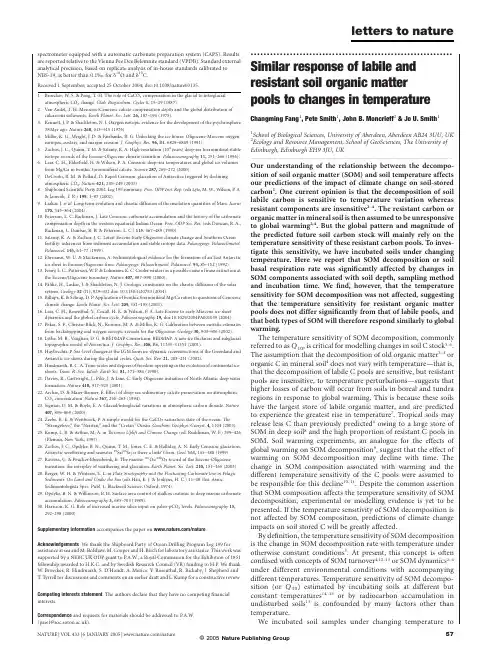
spectrometer equipped with a automatic carbonate preparation system(CAPS).Results are reported relative to the Vienna Pee Dee Belemnite standard(VPDB).Standard external analytical precision,based on replicate analysis of in-house standards calibrated to NBS-19,is better than0.1‰for d18O and d13C.Received1September;accepted25October2004;doi:10.1038/nature03135.1.Broecker,W.S.&Peng,T.-H.The role of CaCO3compensation in the glacial to interglacialatmospheric CO2change.Glob.Biogeochem.Cycles1,15–29(1987).2.Van Andel,T.H.Mesozoic/Cenozoic calcite compensation depth and the global distribution ofcalcareous sediments.Earth Planet.Sci.Lett.26,187–194(1975).3.Kennett,J.P.&Shackleton,N.J.Oxygen isotopic evidence for the development of the psychrosphere38Myr ago.Nature260,513–515(1976).ler,K.G.,Wright,J.D.&Fairbanks,R.G.Unlocking the ice house:Oligocene-Miocene oxygenisotopes,eustasy,and margin erosion.J.Geophys.Res.96,B4,6829–6849(1991).5.Zachos,J.C.,Quinn,T.M.&Salamy,K.A.High-resolution(104years)deep-sea foraminiferal stableisotope records of the Eocene-Oligocene climate transition.Palaeoceanography11,251–266(1996).6.Lear,C.H.,Elderfield,H.&Wilson,P.A.Cenozoic deep-sea temperatures and global ice volumesfrom Mg/Ca in benthic foraminiferal calcite.Science287,269–272(2000).7.DeConto,R.M.&Pollard,D.Rapid Cenozoic glaciation of Antarctica triggered by decliningatmospheric CO2.Nature421,245–249(2003).8.Shipboard Scientific Party2002.Leg199summary.Proc.ODP Init.Rep.(eds Lyle,M.W.,Wilson,P.A.&Janecek,T.R.)199,1–87(2002).skar,J.et al.Long term evolution and chaotic diffusion of the insolation quantities of Mars.Icarus170,343–364(2004).10.Peterson,L.C.Backman,te Cenozoic carbonate accumulation and the history of the carbonatecompensation depth in the western equatorial Indian Ocean.Proc.ODP Sci.Res.(eds Duncan,R.A., Backman,J.,Dunbar,R.B.&Peterson,L.C.)115,467–489(1990).11.Salamy,K.A.&Zachos,test Eocene-Early Oligocene climate change and Southern Oceanfertility:inferences from sediment accumulation and stable isotope data.Palaeogeogr.Palaeoclimatol.Palaeoecol.145,61–77(1999).12.Ehrmann,W.U.&Mackensen,A.Sedimentological evidence for the formation of an East Antarcticice sheet in Eocene/Oligocene time.Palaeogeogr.Palaeoclimatol.Palaeoecol.93,85–112(1992). 13.Ivany,L.C.,Patterson,W.P.&Lohmann,K.C.Cooler winters as a possible cause of mass extinction atthe Eocene/Oligocene boundary.Nature407,887–890(2000).14.Pa¨like,H.,Laskar,J.&Shackleton,N.J.Geologic constraints on the chaotic diffusion of the solarsystem.Geology32(11),929–932doi:10.1130/G20750(2004).15.Billups,K.&Schrag,D.P.Application of benthic foraminiferal Mg/Ca ratios to questions of Cenozoicclimate change.Earth Planet.Sci.Lett.209,181–195(2003).16.Lear,C.H.,Rosenthal,Y.,Coxall,H.K.&Wilson,te Eocene to early Miocene ice-sheetdynamics and the global carbon cycle.Paleoceanography19,doi:10.1029/2004PA001039(2004). 17.Pekar,S.F.,Christie-Blick,N.,Kominz,M.A.&Miller,K.G.Calibration between eustatic estimatesfrom backstripping and oxygen isotopic records for the Oligocene.Geology30,903–906(2002). 18.Lythe,M.B.,Vaughan,D.G.&BEDMAP Consortium,BEDMAP:A new ice thickness and subglacialtopographic model of Antarctica.J.Geophys.Res.106,B6,11335–11351(2001).19.Huybrechts,P.Sea-level changes at the LGM from ice-dynamic reconstructions of the Greenland andAntarctic ice sheets during the glacial cycles.Quat.Sci.Rev.21,203–231(2002).20.Hindmarsh,R.C.A.Time-scales and degrees of freedom operating in the evolution of continental ice-sheets.Trans.R.Soc.Edinb.Earth Sci.81,371–384(1990).21.Davies,R.,Cartwright,J.,Pike,J.&Line,C.Early Oligocene initiation of North Atlantic deep waterformation.Nature410,917–920(2001).22.Archer,D.&Maier-Reimer,E.Effect of deep-sea sedimentary calcite preservation on atmosphericCO2concentration.Nature367,260–263(1994).23.Sigman,D.M.&Boyle,E.A.Glacial/interglacial variations in atmospheric carbon dioxide.Nature407,859–869(2000).24.Zeebe,R.E.&Westbroek,P.A simple model for the CaCO3saturation state of the ocean:The“Strangelove,”the“Neritan,”and the“Cretan”Ocean.Geochem.Geophys.Geosyst.4,1104(2003).25.Kump,L.R.&Arthur,M.A.in Tectonics Uplift and Climate Change(ed.Ruddiman,W.F.)399–426(Plenum,New York,1997).26.Zachos,J.C.,Opdyke,B.N.,Quinn,T.M.,Jones,C.E.&Halliday,A.N.Early Cenozoic glaciation,Antarctic weathering and seawater87Sr/86Sr;is there a link?Chem.Geol.161,165–180(1999). 27.Ravizza,G.&Peucker-Ehrenbrink,B.The marine187Os/188Os record of the Eocene-Oligocenetransition:the interplay of weathering and glaciation.Earth Planet.Sci.Lett.210,151–165(2003).28.Berger,W.H.&Winterer,E.L.in Plate Stratigraphy and the Fluctuating Carbonate line in PelagicSediments:On Land and Under the Sea(eds Hsu¨,K.J.&Jenkyns,H.C.)11–48(Int.Assoc.Sedimentologists Spec.Publ.1,Blackwell Science,Oxford,1974).29.Opdyke,B.N.&Wilkinson,B.H.Surface area control of shallow cratonic to deep marine carbonateaccumulation.Paleoceanography3,685–703(1989).30.Harrison,K.G.Role of increased marine silica input on paleo-pCO2levels.Paleoceanography15,292–298(2000).Supplementary Information accompanies the paper on /nature. Acknowledgements We thank the Shipboard Party of Ocean Drilling Program Leg199for assistance at sea and M.Bolshaw,M.Cooper and H.Birch for laboratory assistance.This work was supported by a NERC UK ODP grant to P.A.W.,a Royal Commission for the Exhibition of1851 fellowship awarded to H.K.C.and by Swedish Research Council(VR)funding to H.P.We thank W.Broecker,R.Hindmarsh,S.D’Hondt,A.Merico,Y.Rosenthal,R.Rickaby,J.Shepherd and T.Tyrrell for discussions and comments on an earlier draft and L.Kump for a constructive review.Competing interests statement The authors declare that they have no competingfinancial interests.Correspondence and requests for materials should be addressed to P.A.W.(paw1@)............................................................... Similar response of labile and resistant soil organic matterpools to changes in temperature Changming Fang1,Pete Smith1,John B.Moncrieff2&Jo U.Smith11School of Biological Sciences,University of Aberdeen,Aberdeen AB243UU,UK 2Ecology and Resource Management,School of GeoSciences,The University of Edinburgh,Edinburgh EH93JU,UK ............................................................................................................................................................................. Our understanding of the relationship between the decompo-sition of soil organic matter(SOM)and soil temperature affects our predictions of the impact of climate change on soil-stored carbon1.One current opinion is that the decomposition of soil labile carbon is sensitive to temperature variation whereas resistant components are insensitive2–4.The resistant carbon or organic matter in mineral soil is then assumed to be unresponsive to global warming2,4.But the global pattern and magnitude of the predicted future soil carbon stock will mainly rely on the temperature sensitivity of these resistant carbon pools.To inves-tigate this sensitivity,we have incubated soils under changing temperature.Here we report that SOM decomposition or soil basal respiration rate was significantly affected by changes in SOM components associated with soil depth,sampling method and incubation time.Wefind,however,that the temperature sensitivity for SOM decomposition was not affected,suggesting that the temperature sensitivity for resistant organic matter pools does not differ significantly from that of labile pools,and that both types of SOM will therefore respond similarly to global warming.The temperature sensitivity of SOM decomposition,commonly referred to as Q10,is critical for modelling changes in soil C stock3–6. The assumption that the decomposition of old organic matter2–3or organic C in mineral soil4does not vary with temperature—that is, that the decomposition of labile C pools are sensitive,but resistant pools are insensitive,to temperature perturbations—suggests that higher losses of carbon will occur from soils in boreal and tundra regions in response to global warming.This is because these soils have the largest store of labile organic matter,and are predicted to experience the greatest rise in temperature7.Tropical soils may release less C than previously predicted4owing to a large store of SOM in deep soil8and the high proportion of resistant C pools in SOM.Soil warming experiments,an analogue for the effects of global warming on SOM decomposition9,suggest that the effect of warming on SOM decomposition may decline with time.The change in SOM composition associated with warming and the different temperature sensitivity of the C pools were assumed to be responsible for this decline10–11.Despite the common assertion that SOM composition affects the temperature sensitivity of SOM decomposition,experimental or modelling evidence is yet to be presented.If the temperature sensitivity of SOM decomposition is not affected by SOM composition,predictions of climate change impacts on soil stored C will be greatly affected.By definition,the temperature sensitivity of SOM decomposition is the change in SOM decomposition rate with temperature under otherwise constant conditions5.At present,this concept is often confused with concepts of SOM turnover4,12–13or SOM dynamics2–4 under different environmental conditions with accompanying different temperatures.Temperature sensitivity of SOM decompo-sition(or Q10)estimated by incubating soils at different but constant temperatures14–16or by radiocarbon accumulation in undisturbed soils13is confounded by many factors other than temperature.We incubated soil samples under changing temperature toletters to natureNATURE|VOL433|6JANUARY2005|/nature57©2005Nature Publishing Groupinvestigate the influence of SOM composition on the temperature dependence of SOM decomposition.Figure 1shows that soil C contents for both labile components (water-dissolved organic carbon (DOC),microbial carbon (C mic )and K 2SO 4-extracted carbon (C KSO ))and the total organic carbon (TOC),are signifi-cantly lower in the subsoil (20–30cm)than in the surface soil (0–10cm).The ratio of DOC:TOC and C KSO :TOC declined signifi-cantly with soil depth (F ¼28.5and 36.1,respectively,P ,0.0001),but C mic :TOC was not significantly affected by depth (F ¼1.9,P ,0.2).After the initial flush of CO 2emission,soil basal respi-ration rate at 208C was (mean ^s.e.m.)6.67^0.46m g CO 2per g dry soil per h for root-free samples in the 0–10cm layer,but only 1.92^0.20m g CO 2per g dry soil per h for the 20–30cm layer.Corresponding values were 6.27^0.66and 1.47^0.16for intact samples.Over a period up to 88days,the subsoil respired only ,0.29^0.13of the CO 2respired in the surface soil.These results indicate that soil basal respiration rate is closely related to variations in C pools occurring at different soil depths.Q 10values for individual soil samples varied in the range 1.97–2.21during the early stage of incubation (up to day 10).No significant correlation was found between Q 10and the rate of basal respiration.Relationships in Fig.1between respiration rate,Q 10value and SOM pools reflect the long-term acclimation of the microbial community to the environment (such as temperature,moisture and O 2)associated with soil depths.During the incubation,there was a significant decline in the labile components (Fig.2c,d,f).After 108days incubation,DOC was 0.73^0.14and C KSO was 0.62^0.065of initial values when averaged over all samples.The greatest variation following incu-bation was observed in C mic .The average C mic at day 42was only 0.43^0.13of the initial content,and less than 0.10^0.0057after 108days incubation.Changes in the average TOC during incu-bation were not significant (Fig.2b).At the end of the incubation,average TOC was 0.94^0.19of the initial content.Soil respiration rate consistently declined with time (Fig.2e).The association between respiration rate and C mic during the incubation suggests that the variation in microbial biomass may be a major cause of the temporal changes in soil respiration.The response of soil basal respiration to temperature was notaffected by the depletion of labile C during the incubation.Q 10values averaged for all samples were in the range 2.01–2.30for the whole incubation period (Fig.2a).There is no significant change in Q 10for soil basal respiration with incubation time,despite the fact that Q 10was more variable during the later stages of incubation.As time progressed,the resistant C component contributed a greater portion of the total soil basal respiration owing to the depletion of labile C pools (Supplementary Fig.2).The Q 10value for soil basal respiration should gradually decrease if resistant C is significantly different from labile pools and insensitive to temperature variation (Supplementary Fig.3).A constant Q 10for soil basal respiration suggests that the temperature dependence of resistant C is not significantly different from that for labile pools.In most incubation experiments,soil samples have been sepa-rately incubated at different but constant temperatures 12,14,15.Three different methods have been used to estimate SOM decomposition and its temperature sensitivity:the total mass loss 3,17,the time required for a given percentage of mass loss 17,and the soil respir-ation rate 14,18.A decline in soil respiration rate was commonly observed as incubation times increased 14,17,19,20.This decline is expected to be greater at higher than at lower temperatures because of the greater depletion and degradation of C pools 21.Temperature sensitivity is likely to be underestimated if turnover rate is derived from studies of total mass loss for a given time period or from respiration rates at different constant temperatures,owing to the higher decline in C turnover rate at higher temperature.If Q 10is estimated using the time required for a given percentage of mass loss,the value will be overestimated.In this case,temporal effects on estimated C turnover rate are more pronounced at lower temperatures than at higher temperatures.Data of total mass loss from soil incubations longer than one year were used to support the opinion that decomposition rates of organic matter in mineral soil do not vary with temperature 4.Estimated C turnover rates from a long-term incubation will be significantly different from those occurring in the field,owing to the quick decline in soil microbial biomass and respiration rate during incubation.In such exper-iments,the temperature sensitivity of SOM decomposition may have been seriously biased or underestimated because respiration rates at all temperatures are close to zero at the later stage of incubation.In soil warming experiments,the observed decline of warming effects on SOM decomposition with time 11does not necessarily mean that the decomposition of resistant C is less sensitive to elevated temperature than the labile component.Provided that the increase in net primary production (NPP)due to warming islessFigure 1Soil carbon components,respiration rate and associated Q 10values with respect to soil depth and sampling method (four replicates for each sample).Respiration rate was an average of data measured at 208C in days 3and 5.The Q 10value was estimated with soil respiration rates under changing temperature for the period of days 3–10.All values are normalized against that of surface root-free sample.Soil respiration rate is significantly related to concentrations of C pools owing to soil depth andsampling method,but Q 10does not change with respiration rate or C concentrations.Error bars indicate standard deviation.DOC,dissolved organic carbon;TOC,total organiccarbon.Figure 2Variations in respiration rate and soil carbon pools with increasing incubation time.Values are averages of all four samples,and normalized by initial values.a ,Q 10value;b ,TOC;c ,DOC;d ,K 2SO 4-extracted C;e ,respiration rate at 208C;and f ,microbial biomass C.Error bars are standard deviation.Respiration rate declined rapidly owing to the depletion of labile components (DOC,C KSO and C mic ),but the Q 10value of soil respiration remained unchanged.letters to natureNATURE |VOL 433|6JANUARY 2005|/nature58© 2005Nature Publishing Groupthan the increase in SOM decomposition rate,a decline in warming effect on SOM decomposition is always expected.In the long-term, the microbial community may become acclimated to warming with changed activities.The contribution of this acclimation is not yet clear.For long-term climate change,the response of the resistant pool of SOM plays a critical role in regulating soil C stocks.Given the predicted climate change in Europe in the next century,the greatest loss of SOM is expected in soils where the present mean annual temperature(MAT)is less than48C,and this net release of SOM will gradually decrease with MAT gradient(Fig.3a–c).(This predicted climate change is climate forcing according to the implementation by the Hadley Centre Climate Model(HadCM3) of the Intergovernmental Panel on Climate Change(IPCC)A1FI (world market–fossil fuel intensive)emission scenario22.)With a moderate change in the temperature sensitivity of the resistant C pool(humus pool of the Rothamsted Carbon Model23only),from Q10¼2.98to about2.58(at108C),sensitivity induced change will significantly reduce the net SOM release in temperate soils(present MAT.48C).By2100,the reduction in SOM loss could be up to 46%in arable soil,37%in grassland,and32%in forest for regions where the present MAT is greater than158C(Fig.3d).At the global scale,this reduction will be large enough to change our prediction of the magnitude and spatial pattern of SOM stocks in the future.Our study does not support the opinion that resistant C pools are significantly less responsive to temperature variation than labile C pools.A MethodsSoil samples(intact and root-free)were collected from a middle-aged plantation of Sitka spruce(Picea sitchensis)in Scotland(568370N,38480W).Mineral soils were collected from four locations in the site at depths of0–10,20–30cm.Root-free samples were made by sieving soil through a2mm mesh to remove plant detritus,root and gravel.For each depth,approximately600–800g soil was taken and packed into a chamber to the original bulk density.Intact soil samples(,10£10cm)were taken next to each root-free sample, following the method of ref.5.Soil samples were analysed to determine TOC24,DOC25and C KSO26.C mic was determined by fumigation extraction26.Samples(16in total)were incubated in the laboratory using a programmable water bath(developed in The University of Edinburgh,UK).Temperature was changed commonly between4and448C (continuously increased from the lowest to the highest with a step of48C and then decreased,reaching a new temperature within two hours).Each temperature was held for about9h.Before and after each round of temperature change,soils were kept at208C for a few days.Soil moisture contents were monitored and adjusted accordingly by adding water at the surface of the soil sample,and fresh air was continuously passed through each chamber during the incubation.Respired CO2was measured with an infrared gas analyser in differential mode,logged every second for7min for each chamber,but only the average over the last four minutes was used.The16chambers were measured sequentially,and four rounds of measurement were made before changing to another temperature.During each round of temperature change,the mean respiration rate at a given temperature was an average of values measured at that temperature when the temperature was increasing and decreasing(Supplementary Fig.1).Mean respiration rates at different temperatures werefitted with an exponential model5ðR¼a exp½ln Q10ðT=10Þ Þto calculate the Q10 value.More information about data analysis is included in the Supplementary Methods, which also explain how we assessed contributions of the resistant C pool to the total SOM decomposition and its Q10.Received30July;accepted22October2004;doi:10.1038/nature03138.1.Lenton,T.M.&Huntingford,C.Global terrestrial carbon storage and uncertainties in its temperaturesensitivity examined with a simple model.Glob.Change Biol.9,1333–1352(2003).2.Liski,J.,Ilvesniemi,H.,Ma¨kela¨,A.&Westman,C.J.CO2emissions from soil in response to climaticwarming are overestimated—The decomposition of old soil organic matter is tolerant of temperature.Ambio28,171–174(1999).3.Thornley,J.H.M.&Cannell,M.G.R.Soil carbon storage response to temperature:a hypothesis.Ann.Bot.87,591–598(2001).4.Giardina,C.P.&Ryan,M.G.Evidence that decomposition rates of organic carbon in mineral soil donot vary with temperature.Nature404,858–861(2000).5.Fang,C.&Moncrieff,J.B.The dependence of soil CO2efflux on temperature.Soil Biol.Biochem.33,155–165(2001).6.Sanderman,J.,Amundson,R.G.&Baldocchi,D.D.Application of eddy covariance measurements tothe temperature dependence of soil organic matter mean residence time.Glob.Biogeochem.Cycles17, doi:10.1029/2001GB001833(2003).7.Schlesinger,W.H.&Andrews,J.A.Soil respiration and the global carbon cycle.Biogeochemistry48,7–20(2000).8.Jobba´gy,E.G.&Jackson,R.B.The vertical distribution of soil organic carbon and its relation toclimate and vegetation.Ecol.Appl.10,423–436(2000).9.Rustad,L.E.et al.A meta-analysis of the response of soil respiration,net nitrogen mineralization,andaboveground plant growth to experimental ecosystem warming.Oecologia126,543–562(2001). 10.Peterjohn,W.T.,Melillo,J.M.&Bowles,S.T.Soil warming and trace gasfluxes:experimental designand preliminaryflux results.Oecologia93,18–24(1993).11.Peterjohn,W.T.et al.Response of trace gasfluxes and N availability to experimentally elevated soiltemperature.Ecol.Appl.4,617–625(1994).12.Dalias,P.,Anderson,J.M.,Bottner,P.&Couˆteaux,M.-M.T emperature responses of carbonmineralization in conifer forest soils from different regional climates incubated under standard laboratory conditions.Glob.Change Biol.6,181–192(2001).13.Trumbore,S.E.,Chadwick,O.A.&Amundson,R.Rapid exchange between soil carbon andatmospheric carbon dioxide driven by temperature change.Science272,393–396(1996).14.Winkler,J.P.,Cherry,R.S.&Schlesinger,W.H.The Q10relationship of microbial respiration in atemperate forest soil.Soil Biol.Biochem.28,1067–1072(1996).15.MacDonald,N.W.,Zak,D.R.&Pregitzer,K.S.Temperature effects on kinetics of microbialrespiration and net nitrogen and sulfur mineralization.Soil Sci.Soc.Am.J.59,233–240(1995). 16.Ross,D.J.&Tate,K.R.Microbial C and N,and respiratory activity,in litter and soil of a southernbeech(Nothofagus)forest:distribution and properties.Soil Biol.Biochem.25,477–483(1994). 17.Reichstein,M.,Bednorz,F.,Broll,G.&Ka¨tterer,T.T emperature dependence of carbon mineralisation:conclusions from a long-term incubation of subalpine soil samples.Soil Biol.Biochem.32,947–958 (2000).18.Fierer,N.,Allen,A.S.,Schimel,J.P.&Holden,P.A.Controls on microbial CO2production:acomparison of surface and subsurface soil horizon.Glob.Change Biol.9,1322–1332(2003).19.Lovell,R.D.&Jarvis,S.C.Soil microbial biomass and activity in soil from different grasslandmanagement treatments stored under controlled conditions.Soil Biol.Biochem.30,2077–2085 (1998).20.Lomander,A.,Ka¨tterer,T.&Andre´n,O.Carbon dioxide evolution from top-and subsoil as affected bymoisture and constant andfluctuating temperature.Soil Biol.Biochem.30,2017–2022(1998). 21.Grisi,B.,Grace,C.,Brookes,P.C.,Benedetti,A.&Dell’abate,M.T.Temperature effects on organicmatter and microbial biomass dynamics in temperate and tropical soils.Soil Biol.Biochem.30, 1309–1315(1998).22.IPCC.Special Report on Emissions Scenarios(Cambridge Univ.Press,Cambridge,UK,2000).23.Coleman,K.&Jenkinson,D.S.in Evaluation of Soil Organic Matter Models Using Existing Long-TermDatasets(eds Powlson,D.S.,Smith,P.&Smith,J.U.)237–246(NATO ASI Series I Vol.38,Springer, Heidelberg,1996).24.Allen,S.E.,Grimshaw,H.M.,Parkingson,J.A.&Quarmby,C.Chemical Analysis of EcologicalMaterials137–139(Blackwell Scientific,Oxford,1974).25.Martin-Olmedo,P.&Rees,R.M.Short-term N availability in response to dissolved organic-carbonfrom poultry manure,alone or in combination with cellulose.Biol.Fert.Soils29,386–393(1999).26.O¨hlinger,R.in Methods in Soil Biology(eds Schinner,F.et al.)56–58(Springer,Berlin,1995). Supplementary Information accompanies the paper on /nature. Acknowledgements We thank M.Wattenbarch and C.Zhang for assistance with the modelling. The pan-European modelling used data sets arising from the EU-funded ATEAM project. Competing interests statement The authors declare that they have no competingfinancial interests.Correspondence and requests for materials should be addressed to C.F.(c.fang@).Figure3Changes in soil C by2100for European soils.The baseline(solid lines in a–c)was from the original Roth-C model23projection(Q10¼2.98at108C for all C pools).Thetemperature sensitivity of humus was changed to80%of the original value(Q10¼2.58at108C,dashed lines in a–c).The loss of soil C is an average of all grid cells(21,976cellsat100£100resolution)according to present MAT.The percentage of net soil C loss withmodified Q10¼2.58for humus is relative to baseline decreases with MAT gradient(d).SOM,soil organic matter.letters to natureNATURE|VOL433|6JANUARY2005|/nature59©2005Nature Publishing Group。
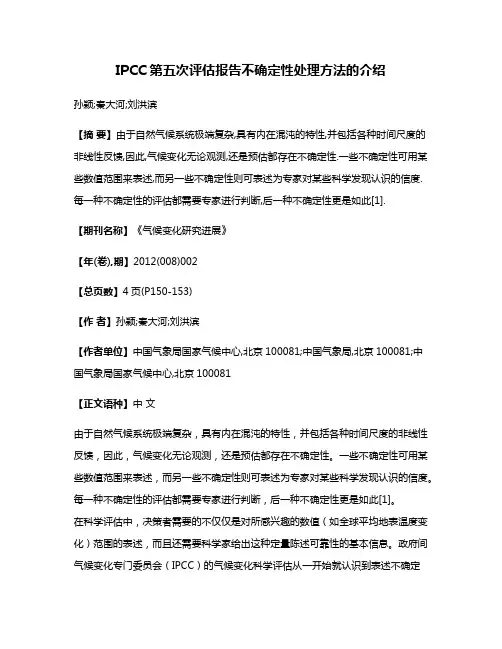
IPCC第五次评估报告不确定性处理方法的介绍孙颖;秦大河;刘洪滨【摘要】由于自然气候系统极端复杂,具有内在混沌的特性,并包括各种时间尺度的非线性反馈,因此,气候变化无论观测,还是预估都存在不确定性.一些不确定性可用某些数值范围来表述,而另一些不确定性则可表述为专家对某些科学发现认识的信度.每一种不确定性的评估都需要专家进行判断,后一种不确定性更是如此[1].【期刊名称】《气候变化研究进展》【年(卷),期】2012(008)002【总页数】4页(P150-153)【作者】孙颖;秦大河;刘洪滨【作者单位】中国气象局国家气候中心,北京100081;中国气象局,北京100081;中国气象局国家气候中心,北京100081【正文语种】中文由于自然气候系统极端复杂,具有内在混沌的特性,并包括各种时间尺度的非线性反馈,因此,气候变化无论观测,还是预估都存在不确定性。
一些不确定性可用某些数值范围来表述,而另一些不确定性则可表述为专家对某些科学发现认识的信度。
每一种不确定性的评估都需要专家进行判断,后一种不确定性更是如此[1]。
在科学评估中,决策者需要的不仅仅是对所感兴趣的数值(如全球平均地表温度变化)范围的表述,而且还需要科学家给出这种定量陈述可靠性的基本信息。
政府间气候变化专门委员会(IPCC)的气候变化科学评估从一开始就认识到表述不确定性的重要性。
在第一次评估报告中,IPCC明确地把对事件的科学认识分为确定的、能够可信地计算得出的、预测的、基于作者判断的等几类,这些分类如今看来仍然非常重要。
IPCC第二次评估报告指出,需要用客观、一致的方法来确定和描述气候变化科学的信度水平。
在确定信度水平时,确保作者们所使用的信息可以追溯到有关的科学文献,从而有效地满足对客观性的要求。
IPCC第三次评估报告是第一个试图针对不同学科和广泛的国际读者群来描述不确定性的科学评估报告,“可能性”和“信度”语言的使用成为第三次评估报告的一个特征。
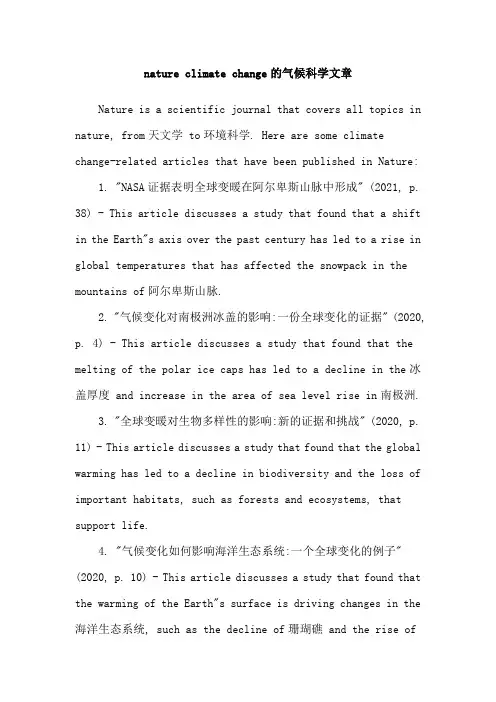
nature climate change的气候科学文章Nature is a scientific journal that covers all topics in nature, from天文学 to环境科学. Here are some climate change-related articles that have been published in Nature: 1. "NASA证据表明全球变暖在阿尔卑斯山脉中形成" (2021, p.38) - This article discusses a study that found that a shift in the Earth"s axis over the past century has led to a rise in global temperatures that has affected the snowpack in the mountains of阿尔卑斯山脉.2. "气候变化对南极洲冰盖的影响:一份全球变化的证据" (2020, p. 4) - This article discusses a study that found that the melting of the polar ice caps has led to a decline in the冰盖厚度 and increase in the area of sea level rise in南极洲.3. "全球变暖对生物多样性的影响:新的证据和挑战" (2020, p.11) - This article discusses a study that found that the global warming has led to a decline in biodiversity and the loss of important habitats, such as forests and ecosystems, that support life.4. "气候变化如何影响海洋生态系统:一个全球变化的例子" (2020, p. 10) - This article discusses a study that found that the warming of the Earth"s surface is driving changes in the 海洋生态系统, such as the decline of珊瑚礁 and the rise of尺紀梁海, that can impact global trade and coastal security.5. "气候变化如何影响农业和生态系统服务:来自中国的证据" (2020, p. 19) - This article discusses a study that found that the warming has led to a decline in agricultural productivity and the loss of important生态系统服务, such as game species and birdlife, that support human well-being.These articles provide a great overview of the latest research on climate change and its impact on nature.。
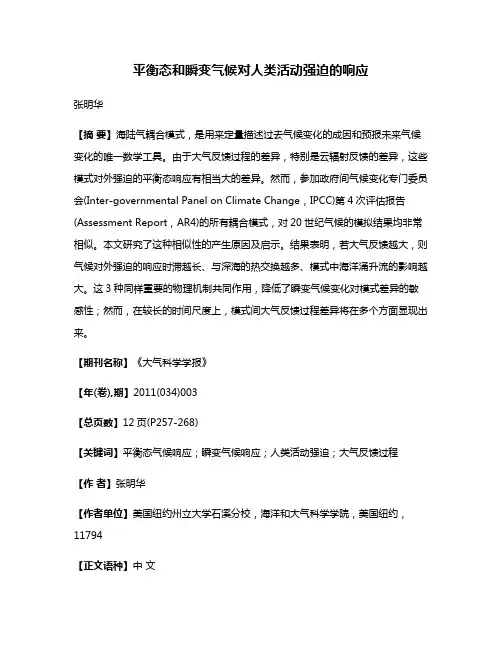
平衡态和瞬变气候对人类活动强迫的响应张明华【摘要】海陆气耦合模式,是用来定量描述过去气候变化的成因和预报未来气候变化的唯一数学工具。
由于大气反馈过程的差异,特别是云辐射反馈的差异,这些模式对外强迫的平衡态响应有相当大的差异。
然而,参加政府间气候变化专门委员会(Inter-governmental Panel on Climate Change,IPCC)第4次评估报告(Assessment Report,AR4)的所有耦合模式,对20世纪气候的模拟结果均非常相似。
本文研究了这种相似性的产生原因及启示。
结果表明,若大气反馈越大,则气候对外强迫的响应时滞越长、与深海的热交换越多、模式中海洋涌升流的影响越大。
这3种同样重要的物理机制共同作用,降低了瞬变气候变化对模式差异的敏感性;然而,在较长的时间尺度上,模式间大气反馈过程差异将在多个方面显现出来。
【期刊名称】《大气科学学报》【年(卷),期】2011(034)003【总页数】12页(P257-268)【关键词】平衡态气候响应;瞬变气候响应;人类活动强迫;大气反馈过程【作者】张明华【作者单位】美国纽约州立大学石溪分校,海洋和大气科学学院,美国纽约,11794【正文语种】中文【中图分类】P4350 引言气候敏感度是指全球平均表面温度对某种特定外强迫的响应程度。
人类燃烧化石燃料导致了大气中的温室气体不断增加。
认知全球表面温度对人类活动响应的程度,即气候系统的敏感度,是近30 a的研究热点之一(Randall et al.,2007)。
耦合模式(Coupled General Circulation Models,CGCMs)是研究气候敏感度的少数几个有效工具之一。
早期研究采用的是带有海洋混合层的大气环流模式。
在定常外强迫条件下,人们通过积分模式到平衡态去研究气候敏感度(Hansen et al.,1984;Wetherald and Manabe,1988)。
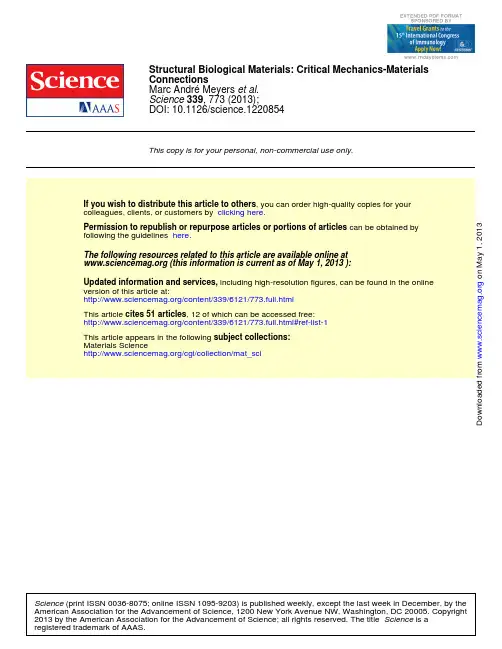
DOI: 10.1126/science.1220854, 773 (2013);339 Science et al.Marc André Meyers ConnectionsStructural Biological Materials: Critical Mechanics-MaterialsThis copy is for your personal, non-commercial use only.clicking here.colleagues, clients, or customers by , you can order high-quality copies for your If you wish to distribute this article to othershere.following the guidelines can be obtained by Permission to republish or repurpose articles or portions of articles): May 1, 2013 (this information is current as of The following resources related to this article are available online at/content/339/6121/773.full.html version of this article at:including high-resolution figures, can be found in the online Updated information and services, /content/339/6121/773.full.html#ref-list-1, 12 of which can be accessed free:cites 51 articles This article/cgi/collection/mat_sci Materials Sciencesubject collections:This article appears in the following registered trademark of AAAS.is a Science 2013 by the American Association for the Advancement of Science; all rights reserved. The title Copyright American Association for the Advancement of Science, 1200 New York Avenue NW, Washington, DC 20005. (print ISSN 0036-8075; online ISSN 1095-9203) is published weekly, except the last week in December, by the Science o n M a y 1, 2013w w w .s c i e n c e m a g .o r g D o w n l o a d e d f r o mStructural BiologicalMaterials:CriticalMechanics-Materials ConnectionsMarc AndréMeyers,1,2*Joanna McKittrick,1Po-Yu Chen3Spider silk is extraordinarily strong,mollusk shells and bone are tough,and porcupine quills and feathers resist buckling.How are these notable properties achieved?The building blocks of the materials listed above are primarily minerals and biopolymers,mostly in combination;the first weak in tension and the second weak in compression.The intricate and ingenious hierarchical structures are responsible for the outstanding performance of each material.Toughness is conferred by the presence of controlled interfacial features(friction,hydrogen bonds,chain straightening and stretching);buckling resistance can be achieved by filling a slender column with a lightweight foam.Here,we present and interpret selected examples of these and other biological materials.Structural bio-inspired materials design makes use of the biological structures by inserting synthetic materials and processes that augment the structures’capability while retaining their essential features.In this Review,we explain this idea through some unusual concepts.M aterials science is a vibrant field of in-tellectual endeavor and research.Thisfield applies physics and chemistry, melding them in the process,to the interrela-tionship between structure,properties,and perform-ance of complex materials with technological applications.Thus,materials science extends these rigorous scientific disciplines into complex ma-terials that have structures providing properties and synergies beyond those of pure and simple solids.Initially geared at synthetic materials,ma-terials science has recently extended its reach into biology,especially into the extracellular matrix, whose mechanical properties are of utmost im-portance in living organisms.Some of the semi-nal work and important contributions in this field are either presented or reviewed in(1–5).There are a number of interrelated features that define biological materials and distinguish them from their synthetic counterparts[inspired by Arzt(6)]: (i)Self-assembly.In contrast to many synthetic processes to produce materials,the structures are assembled from the bottom up,rather than from the top down.(ii)Multi-functionality.Many com-ponents serve more than one purpose.For exam-ple,feathers provide flight capability,camouflage, and insulation,whereas bones provide structural framework,promote the growth of red blood cells, and provide protection to the internal organs.(iii) Hierarchy.Different,organized scale levels(nano-to ultrascale)confer distinct and translatable prop-erties from one level to the next.We are starting to develop a systematic and quantitative understandingof this hierarchy by distinguishing the character-istic levels,developing constitutive descriptionsof each level,and linking them through appro-priate and physically based equations,enabling afull predictive understanding.(iv)Hydration.Theproperties are highly dependent on the level ofwater in the structure.There are some exceptions,such as enamel,but this rule applies to mostbiological materials and is of importance to me-chanical properties such as strength(which isdecreased by hydration)and toughness(which isincreased).(v)Mild synthesis conditions.Themajority of biological materials are fabricated atambient temperature and pressure as well as in anaqueous environment,a notable difference fromsynthetic materials fabrication.(vi)Evolution andenvironmental constraints.The limited availabil-ity of useful elements dictates the morphologyand resultant properties.The structures are notnecessarily optimized for all properties but arethe result of an evolutionary process leading tosatisfactory and robust solutions.(vii)Self-healingcapability.Whereas synthetic materials undergodamage and failure in an irreversible manner,biological materials often have the capability,due to the vascularity and cells embedded in thestructure,to reverse the effects of damage byhealing.The seven characteristics listed above arepresent in a vast number of structures.Nevertheless,the structures of biological materials can bedivided into two broad classes:(i)non-mineralized(“soft”)structures,which are composed of fibrousconstituents(collagen,keratin,elastin,chitin,lignin,and other biopolymers)that display widelyvarying mechanical properties and anisotropiesdepending on the function,and(ii)mineralized(“hard”)structures,consisting of hierarchicallyassembled composites of minerals(mainly,butnot solely,hydroxyapatite,calcium carbonate,and amorphous silica)and organic fibrous com-ponents(primarily collagen and chitin).The mechanical behavior of biological con-stituents and composites is quite diverse.Bio-minerals exhibit linear elastic stress-strain plots,whereas the biopolymer constituents are non-linear,demonstrating either a J shape or a curvewith an inflection point.Foams are characterizedby a compressive response containing a plastic orcrushing plateau in which the porosity is elim-inated.Many biological materials are compositeswith many components that are hierarchicallystructured and can have a broad variety of con-stitutive responses.Below,we present some of thestructures and functionalities of biological ma-terials with examples from current research.Here,we focus on three points:(i)How high tensilestrength is achieved(biopolymers),(ii)how hightoughness is attained(composite structures),and(iii)how bending resistance is achieved in light-weight structures(shells with an interior foam).Structures in Tension:Importance of BiopolymersThe ability to sustain tensile forces requires aspecific set of molecular and configurational con-formations.The initial work performed on exten-sion should be small,to reduce energy expenditure,whereas the material should stiffen close to thebreaking point,to resist failure.Thus,biopolymers,such as collagen and viscid(catching spiral)spidersilk,have a J-shaped stress-strain curve where mo-lecular uncoiling and unkinking occur with con-siderable deformation under low stress.This stiffening as the chains unfurl,straighten,stretch,and slide past each other can be repre-sented analytically in one,two,and three dimen-sions.Examples are constitutive equations initiallydeveloped for polymers by Ogden(7)and Arrudaand Boyce(8).An equation specifically proposedfor tissues is given by Fung(3).A simpler for-mulation is given here;the slope of the stress-strain(s-e)curve increases monotonically with strain.Thus,one considers two regimes:(i)unfurlingand straightening of polymer chainsd sd eºe nðn>1Þð1Þand(ii)stretching of the polymer chain backbonesd sd eºEð2Þwhere E is the elastic modulus of the chains.Thecombined equation,after integrating Eqs.1and2,iss=k1e n+1+H(e c)E(e–e c)(3)Here k1is a parameter,and H is the Heavisidefunction,which activates the second term at e=e c,where e c is a characteristic strain at whichcollagen fibers are fully extended.Subsequent straingradually becomes dominated by chain stretch-ing.The computational results by Gautieri et al.(9)on collagen fibrils corroborate Eq.3for n=1.This corresponds to a quadratic relation between1Department of Mechanical and Aerospace Engineering andMaterials Science and Engineering Program,University ofCalifornia,San Diego,La Jolla,CA92093,USA.2Department ofNanoengineering,University of California,San Diego,La Jolla,CA92093,USA.3Department of Materials Science and En-gineering,National Tsing Hua University,Hsinchu30013,Taiwan,Republic of China.*To whom correspondence should be addressed.E-mail:mameyers@ SCIENCE VOL33915FEBRUARY2013773o n M a y 1 , 2 0 1 3 w w w . s c i e n c e m a g . o r g D o w n l o a d e d f r o mstress and strain (s ºe 2),which has the char-acteristic J shape.Collagen is the most important structural bio-logical polymer,as it is the key component in many tissues (tendon,ligaments,skin,and bone),as well as in the extracellular matrix.The de-formation process is intimately connected to the different hierarchical levels,starting with the poly-peptides (0.5-nm diameter)to the tropocollagen molecules (1.5-nm diameter),then to the fibrils (~40-to 100-nm diameter),and finally to fibers (~1-to 10-m m diameter)and fascicles (>10-m m diameter).Molecular dynamics computations (9)of entire fibrils show the J -curve response;these computational predictions are well matched to atomic force microscopy (AFM)(10),small-angle x-ray scattering (SAXS)(11),and experiments by Fratzl et al .(12),as shown in Fig.1A.The effect of hydration is also seen and is of great impor-tance.The calculated density of collagen de-creases from 1.34to 1.19g/cm 3with hydration and is accompanied by a decrease in the Young ’s modulus from 3.26to 0.6GPa.The response of silk and spider thread is fascinating.As one of the toughest known ma-terials,silk also has high tensile strength and extensibility.It is composed of b sheet (10to 15volume %)nanocrystals [which consist of highly conserved poly-(Gly-Ala)and poly-Ala domains]embedded in a disordered matrix (13).Figure 1B shows the J -shape stress-strain curve and molecular configurations for the crystalline domains in silkworm (Bombyx mori )silk (14).Similar to collagen,the low-stress region corre-sponds to uncoiling and straightening of the pro-tein strands.This region is followed by entropic unfolding of the amorphous strands and then stiffening due to load transfer to the crystalline b sheets.Despite the high strength,the major mo-lecular interactions in the b sheets are weak hy-drogen bonds.Molecular dynamics simulations,Fig.1.Tensile stress-strain relationships in bio-polymers.(A )J -shaped curve for hydrated and dry collagen fibrils obtained from molecular dynamics (MD)simulations and AFM and SAXS studies.At low stress levels,considerable stretching occurs due to the uncrimping and unfolding of molecules;at higher stress levels,the polymer backbone stretches.Adapted from (9,12).(B )Stretching of dragline spider silk and molecular schematic of the protein fibroin.At low stress levels,entropic effects domi-nate (straightening of amorphous strands);at higher levels,the crystalline parts sustain the load.(C )Mo-lecular dynamics simulation of silk:(i)short stack and (ii)long stack of b -sheet crystals,showing that a higher pullout force is required in the short stack;for the long stack,bending stresses become im-portant.Hydrogen bonds connect b -sheet crystals.Adapted from (14).(D )Egg whelk case (bioelastomer)showing three regions:straightening of the a helices,the a helix –to –b sheet transformation,and b -sheet extension.A molecular schematic is shown.Adapted from (18).300.000.2Yield pointEntropic unfoldingMD simulationsStick slipStiffening β-crystal123456700012345670102030405050010001500200025050075010001250150017500.40.60.80.010.020.030.040.05MD wet (Gautieri et al)SAXS (Sasaki and Odajima)AFM (Aladin et al)MD dry (Gautieri et al)2520151050S t r e s s (M P a )S t r e s s(M P a )StrainABCDStrain (m/m)Length (nm)Length (nm)Stick-slip deformation (robust)"brittle" fracture (fragile)i iiP u l l -o u t f o r c e (p N )00.20.4Native state Unloading: reformation of α-helicesDomain 4: Extension andalignmentof β-sheets0.60.8ε=0ε4ε=01.0012345StrainS t r e s s (M P a )E n e r g y /v o l u m e (k c a l /m o l /n m 3)L e n g t hI I II II III IIIIVIVFDomain 3: Formation of β-sheetsfrom random coilsε3Domain 2: Extension of random coilsε2Domain 1: Unraveling of α-helicesinto random coilsε1Toughness (MD)Resilience (MD)T=-1°C T=20°C T=40°C T=60°C T=80°C15FEBRUARY 2013VOL 339SCIENCE 774REVIEWo n M a y 1, 2013w w w .s c i e n c e m a g .o r g D o w n l o a d e d f r o mshown in Fig.1C,illustrate an energy dissipative stick-slip shearing of the hydrogen bonds during failure of the b sheets (14).For a stack with a height L ≤3nm (left-hand side of Fig.1C),the shear stresses are more substantial than the flex-ure stresses,and the hydrogen bonds contribute to the high strength obtained (1.5GPa).How-ever,if the stack of b sheets is too high (right-hand side of Fig.1C),it undergoes bending with tensile separation between adjacent sheets.The nanoscale dimension of the b sheets allows for a ductile instead of brittle failure,resulting in high toughness values of silk.Thus,size affects the mechanical response considerably,changing the deformation characteristics of the weak hydro-gen bonds.This has also been demonstrated in bone (15–17),where sacrificial hydrogen bonds between mineralized collagen fibrils contribute to the excellent fracture resistance.Other biological soft materials have more complex responses,marked by discontinuities in d s /d e .This is the case for wool,whelk eggs,silks,and spider webs.Several mechanisms are responsible for this change in slope;for instance,the transition from a -to b -keratin,entropic changes with strain (such as those prevalent in rubber,where chain stretching and alignment decrease entropy),and others.The example of egg whelk is shown in Fig.1D (18).In this case,there is a specific stress at which a -keratin heli-ces transform to b sheets,with an associated change in length.Upon unloading,the reverse occurs,and the total reversible strain is,therefore,extensive.This stress-induced phase transforma-tion is similar to what occurs in shape-memory alloys.Thus,this material can experience sub-stantial reversible deformation (up to 80%)in a reversible fashion,when the stress is raised from 2to 5MPa,ensuring the survival of whelk eggs,which are continually swept by waves.These examples demonstrate the distinct properties of biopolymers that allow these ma-terials to be strong and highly extensible with distinctive molecular deformation characteristics.However,many interesting biological materials are composites of flexible biopolymers and stiff minerals.The combination of these two constit-uents leads to the creation of a tough material.Imparting Toughness:Importance of Interfaces One hallmark property of most biological com-posites is that they are tough.Toughness is defined as the amount of energy a material ab-sorbs before it fails,expressed asU ¼∫e fs d eð4Þwhere U is the energy per volume absorbed,s is the stress,e is the strain,and e f is the failure strain.Tough materials show considerable plastic deformation (or permanent damage)coupled with considerable strength.This maximizes the integral expression in Eq.4.Biological com-posite materials (for example,crystalline and noncrystalline components)have a plethora oftoughening mechanisms,many of which depend on the presence of interfaces.As a crack im-pinges on an interface or discontinuity in the material,the crack can be deflected around the interface (requiring more energy to propagate than a straight crack)or can drive through it.The strength of biopolymer fibers in tension im-pedes crack opening;bridges between micro-cracks are another mechanism.The toughening mechanisms have been divided into intrinsic (ex-isting in the material ahead of crack)and extrinsic (generated during the progression of failure)cat-egories (19).Thus,toughening is accomplished by a wide variety of stratagems.We illustrate this concept for four biological materials,shown in Fig.2.All inorganic materials contain flaws and cracks,which reduce the strength from the theo-retical value (~E /10to E /30).The maximum stress (s max )a material can sustain when a preexisting crack of length a is present is given by the Griffith equations max ¼ffiffiffiffiffiffiffiffiffiffi2g s E p a r ¼YK Icffiffiffiffiffip ap ð5Þwhere E is the Young ’s modulus,g s is the sur-face (or damage)energy,and Y is a geometric parameter.K Ic ¼Y −1ffiffiffiffiffiffiffiffiffiffi2g s E p is the fracture toughness,a materials property that expresses the ability to resist crack propagation.Abalone (Haliotis rufescens )nacre has a fracture tough-ness that is vastly superior to that of its major constituent,monolithic calcium carbonate,due to an ordered assembly consisting of mineral tiles with an approximate thickness of 0.5m m and a diameter of ~10m m (Fig.2A).Additionally,this material contains organic mesolayers (separated by ~300m m)that are thought to be seasonal growth bands.The tiles are connected by mineral bridges with ~50-nm diameter and are separated by organic layers,consisting of a chitin network and acidic proteins,which,when combined,have a similar thickness to the mineral bridge diame-ters.The Griffith fracture criterion (Eq.5)can be applied to predict the flaw size (a cr )at which the theoretical strength s th is achieved.With typical values for the fracture toughness (K Ic ),s th ,and E ,the critical flaw size is in the range of tens of nanometers.This led Gao et al .(20)to propose that at sufficiently small dimensions (less than the critical flaw size),materials become insensitive to flaws,and the theoretical strength (~E /30)should be achieved at the nanoscale.However,the strength of the material will be determined by fracture mechanisms operating at all hierar-chical levels.The central micrograph in Fig.2A shows how failure occurs by tile pullout.The interdigitated structure deflects cracks around the tiles instead of through them,thereby increasing the total length of the crack and the energy needed to fracture (increasing the toughness).Thus,we must de-termine how effectively the tiles resist pullout.Three contributions have been identified and are believed to operate synergistically (21).First,themineral bridges are thought to approach thetheoretical strength (10GPa),thereby strongly attaching the tiles together (22).Second,the tile surfaces have asperities that are produced during growth (23)and could produce frictional resist-ance and strain hardening (24).Third,energy is required for viscoelastic deformation (stretching and shearing)of the organic layer (25).One important aspect on the mechanical prop-erties is the effect of alignment of the mineral crystals.The oriented tiles in nacre result in an-isotropic properties with the strength and modulus higher in the longitudinal (parallel to the organic layers)than in the transverse direction.For a composite with a dispersed mineral m of volume fraction V m embedded in a biopolymer (bp)matrix that has a much lower strength and Young ’s modulus than the mineral,the ratio of the lon-gitudinal (L)and transverse (T)properties P (such as elastic modulus)can be expressed,in simpli-fied form,asP L P T ¼P mP bpV m ð1−V m Þð6ÞThus,the longitudinal properties are much higher than the transverse properties.This aniso-tropic response is also observed in other oriented mineralized materials,such as bone and teeth.Another tough biological material is the exo-skeleton of an arthropod.In the case of marine animals [for instance,lobsters (26,27)and crabs (28)],the exoskeleton structure consists of layers of mineralized chitin in a Bouligand arrange-ment (successive layers at the same angle to each other,resulting in a helicoidal stacking sequence and in-plane isotropy).These layers can be en-visaged as being stitched together with ductile tubules that also perform other functions,such as fluid transport and moisture regulation.The cross-ply Bouligand arrangement is effective in crack stopping;the crack cannot follow a straight path,thereby increasing the materials ’toughness.Upon being stressed,the mineral components frac-ture,but the chitin fibers can absorb the strain.Thus,the fractured region does not undergo physical separation with dispersal of fragments,and self-healing can take place (29).Figure 2B shows the structure of the lobster (Homarus americanus )exoskeleton with the Bouligand ar-rangement of the fibers.Bone is another example of a biological ma-terial that demonstrates high toughness.Skeletal mammalian bone is a composite of hydroxyapatite-type minerals,collagen and water.On a volu-metric basis,bone consists of ~33to 43volume %minerals,32to 44volume %organics,and 15to 25volume %water.The Young ’s modulus and strength increase,but the toughness decreases with increasing mineral volume fraction (30).Cortical (dense)mammalian bone has blood ves-sels extending along the long axis of the limbs.In animals larger than rats,the vessel is encased in a circumferentially laminated structure called the osteon.Primary osteons are surrounded by hypermineralized regions,whereas secondary SCIENCEVOL 33915FEBRUARY 2013775REVIEWo n M a y 1, 2013w w w .s c i e n c e m a g .o r g D o w n l o a d e d f r o m(remodeled)osteons are surrounded by a cement line (also of high mineral content)(31).In mam-malian cortical bone,the following intrinsic toughening mechanisms have been identified:molecular uncoiling and intermolecular sliding of collagen,fibrillar sliding of collagen bonds,and microcracking of the mineral matrix (19).Extrinsic mechanisms are collagen fibril bridging,uncracked ligament bridging,and crack deflec-tion and twisting (19).Rarely does a limb bone snap in two with smooth fracture surfaces;the crack is often deflected orthogonal to the crack front direction.In the case of (rehydrated)elk (Cervus elaphus )antler bone (shown in Fig.2C)(32),which has the highest toughness of any bone type by far (33),the hypermineralized re-gions around the primary osteons lead to crackdeflection,and the high amount of collagen (~60volume %)adds mechanisms of crack re-tardation and creates crack bridges behind the crack front.The toughening effect in antlers has been estimated as:crack deflection,60%;un-cracked ligament bridges,35%;and collagen as well as fibril bridging,5%(33).A particu-larly important feature in bone is that the fracture toughness increases as the crack propagates,as shown in the plot.This plot demonstrates the crack extension resistance curve,or R -curve,behavior,which is the rate of the total energy dissipated as a function of the crack size.This occurs by the activation of the extrinsic tough-ening mechanisms.In this manner,it becomes gradually more difficult to advance the crack.In human bone,the cracks are deflected and/ortwisted around the cement lines surrounding the secondary osteons and also demonstrate R -curve behavior (34).The final example illustrating how the presence of interfaces is used to retard crack propagation is the glass sea sponge (Euplectella aspergillum ).The entire structure of the V enus ’flower basket is shown in Fig.2D.Biological silica is amorphous and,within the spicules,consists of concentric layers,separated by an organic material,silicatein (35,36).The flexure strength of the spicule notably exceeds (by approximately fivefold)that of monolithic glass (37).The principal reason is the presence of interfaces,which can arrest and/or deflect the crack.Biological materials use ingenious meth-ods to retard the progression of cracks,therebyAbalone shell: NacreMineral bridgesLobsterDeer antlerChitin fibril networkHuman cortical boneMineral crystallitesPrimary osteonsSubvelvet/compact Subvelvet/cCompact Comp p actTransition zoneCancellousCollagen fibrilsDeep sea spongeSkeletonSpicules20 mm1 cmHuman cortical boneElk antlerTransverseIn-plane longitudinalASTM validASTM invalid Mesolayers ABCD0.1 mm500 nm500 nm ˜1 nm˜3 nm˜20 nmCrack extension, ⌬a (mm)T o u g h n e s s , J (k J m -2)50 nm200 nm 10 m500 nm2 m1 m200 m300 m˜10 m0.010.11101000.20.40.6500 00 nm50 nmFig.2.Hierarchical structures of tough biological materials demonstrating the heterogeneous interfaces that provide crack deflection.(A )Abalone nacre showing growth layers (mesolayers),mineral bridges between mineral tiles and asperities on the surface,the fibrous chitin network that forms the backbone of the inorganic layer,and an example of crack tortuosity in which the crack must travel around the tiles instead of through them [adapted from (4,21)].(B )Lobster exoskeleton showing the twisted plywood structure of the chitin (next to the shell)and the tubules that extend from the chitin layers to the animal [adapted from (27)].(C )Antler bone image showing the hard outer sheath (cortical bone)surrounding the porous bone.The collagen fibrils are highly aligned in the growth direction,with nanocrystalline minerals dispersed in and around them.The osteonal structure in a cross section of cortical bone illustrates the boundaries where cracks perpendicular to the osteons can be directed [adapted from (33)].ASTM,American Society for Testing and Mate-rials.(D )Silica sponge and the intricate scaffold of spicules.Each spicule is a circumferentially layered rod:The interfaces between the layers assist in ar-resting crack anic silicate in bridging adjacent silica layers is observed at higher magnification (red arrow)(36).15FEBRUARY 2013VOL 339SCIENCE776REVIEWo n M a y 1, 2013w w w .s c i e n c e m a g .o r g D o w n l o a d e d f r o mincreasing toughness.These methods operate at levels ranging from the nanoscale to the structur-al scale and involve interfaces to deflect cracks,bridging by ductile phases (e.g.,collagen or chitin),microcracks forming ahead of the crack,delocal-ization of damage,and others.Lightweight Structures Resistant to Bending,Torsion,and Buckling —Shells and FoamsResistance to flexural and torsional tractions with a prescribed deflection is a major attribute of many biological structures.The fundamental mechanics of elastic (recoverable)deflection,as it relates to the geometrical characteristics of beams and plates,is given by two equations:The first relates the bending moment,M ,to the curvature of the beam,d 2y /dx 2(y is the deflection)d 2y dx 2¼MEIð7Þwhere I is the area moment of inertia,which de-pends on the geometry of the cross section (I =p R 4/4,for circular sections,where R is the ra-dius).Importantly,the curvature of a solid beam,and therefore its deflection,is inversely propor-tional to the fourth power of the radius.The sec-ond equation,commonly referred to as Euler ’s buckling equation,calculates the compressive load at which global buckling of a column takes place (P cr )P cr ¼p 2EI ðkL Þ2ð8Þwhere k is a constant dependent on the column-end conditions (pinned,fixed,or free),and L is the length of the column.Resistance to buck-ing can also be accomplished by increasing I .Both Eqs.7and 8predict the principal designLongitudinal sectionToucan beak Keratin layers(i) Fibers(circumferential)Megafibrils and fibrilsBarbsBarbulesCortexCortical ridgesFoamRachisNodes(iii) Medulloidpith(ii) Fibers (longitudinal)Feather rachisPlant-Bird of ParadisePorcupine quillsNodesRebarClosed-cell foamTransverseLongitudinalCross sectionABCD5 mm 1 mm1 cm 0.1 mm5m 5 m m1c 1 c m1 mm100 m500 mFig.3.Low-density and stiff biological materials.The theme is a dense outer layer and a low-density core,which provides a high bending strength –to –weight ratio.(A )Giant bird of paradise plant stem showing the cellular core with porous walls.(B )Porcupine quill exhibiting the dense outer cortex surrounding a uniform,closed-cell foam.Taken from (42).(C )Toucan beak showing the porousinterior (bone)with a central void region [adapted from (43)].(D )Schematic view of the three major structural components of the feather rachis:(i)superficial layers of fibers,wound circumferentially around the rachis;(ii)the majority of the fibers extending parallel to the rachidial axis and through the depth of the cortex;and (iii)foam comprising gas-filled polyhedral structures.Taken from (45)SCIENCEVOL 33915FEBRUARY 2013777REVIEWo n M a y 1, 2013w w w .s c i e n c e m a g .o r g D o w n l o a d e d f r o m。
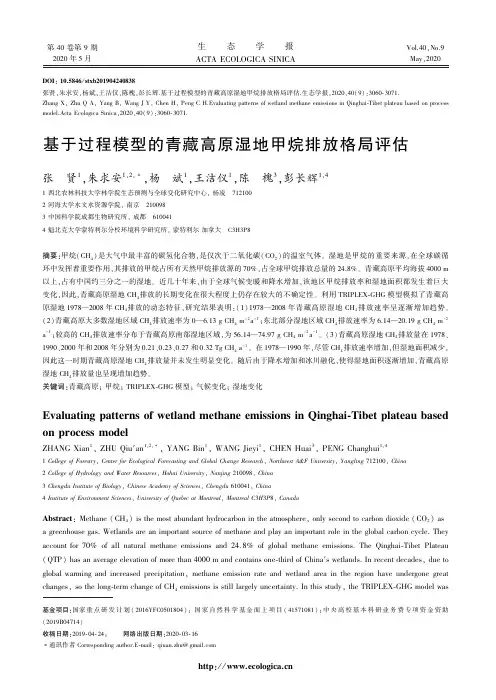
第40卷第9期2020年5月生态学报ACTAECOLOGICASINICAVol.40,No.9May,2020基金项目:国家重点研发计划(2016YFC0501804);国家自然科学基金面上项目(41571081);中央高校基本科研业务费专项资金资助(2019B04714)收稿日期:2019⁃04⁃24;㊀㊀网络出版日期:2020⁃03⁃16∗通讯作者Correspondingauthor.E⁃mail:qiuan.zhu@gmail.comDOI:10.5846/stxb201904240838张贤,朱求安,杨斌,王洁仪,陈槐,彭长辉.基于过程模型的青藏高原湿地甲烷排放格局评估.生态学报,2020,40(9):3060⁃3071.ZhangX,ZhuQA,YangB,WangJY,ChenH,PengCH.EvaluatingpatternsofwetlandmethaneemissionsinQinghai⁃Tibetplateaubasedonprocessmodel.ActaEcologicaSinica,2020,40(9):3060⁃3071.基于过程模型的青藏高原湿地甲烷排放格局评估张㊀贤1,朱求安1,2,∗,杨㊀斌1,王洁仪1,陈㊀槐3,彭长辉1,41西北农林科技大学林学院生态预测与全球变化研究中心,杨凌㊀7121002河海大学水文水资源学院,南京㊀2100983中国科学院成都生物研究所,成都㊀6100414魁北克大学蒙特利尔分校环境科学研究所,蒙特利尔加拿大㊀C3H3P8摘要:甲烷(CH4)是大气中最丰富的碳氢化合物,是仅次于二氧化碳(CO2)的温室气体㊂湿地是甲烷的重要来源,在全球碳循环中发挥着重要作用,其排放的甲烷占所有天然甲烷排放源的70%,占全球甲烷排放总量的24.8%㊂青藏高原平均海拔4000m以上,占有中国约三分之一的湿地㊂近几十年来,由于全球气候变暖和降水增加,该地区甲烷排放率和湿地面积都发生着巨大变化,因此,青藏高原湿地CH4排放的长期变化在很大程度上仍存在较大的不确定性㊂利用TRIPLEX⁃GHG模型模拟了青藏高原湿地1978 2008年CH4排放的动态特征,研究结果表明:(1)1978 2008年青藏高原湿地CH4排放速率呈逐渐增加趋势㊂(2)青藏高原大多数湿地区域CH4排放速率为0 6.13gCH4m-2a-1;东北部分湿地区域CH4排放速率为6.14 20.19gCH4m-2a-1;较高的CH4排放速率分布于青藏高原南部湿地区域,为56.14 74.97gCH4m-2a-1㊂(3)青藏高原湿地CH4排放量在1978㊁1990㊁2000年和2008年分别为0.21㊁0.23㊁0.27和0.32TgCH4a-1㊂在1978 1990年,尽管CH4排放速率增加,但湿地面积减少,因此这一时期青藏高原湿地CH4排放量并未发生明显变化㊂随后由于降水增加和冰川融化,使得湿地面积逐渐增加,青藏高原湿地CH4排放量也呈现增加趋势㊂关键词:青藏高原;甲烷;TRIPLEX⁃GHG模型;气候变化;湿地变化EvaluatingpatternsofwetlandmethaneemissionsinQinghai⁃TibetplateaubasedonprocessmodelZHANGXian1,ZHUQiuᶄan1,2,∗,YANGBin1,WANGJieyi1,CHENHuai3,PENGChanghui1,41CollegeofForestry,CenterforEcologicalForecastingandGlobalChangeResearch,NorthwestA&FUniversity,Yangling712100,China2CollegeofHydrologyandWaterResources,HohaiUniversity,Nanjing210098,China3ChengduInstituteofBiology,ChineseAcademyofSciences,Chengdu610041,China4InstituteofEnvironmentSciences,UniversityofQuebecatMontreal,MontrealC3H3P8,CanadaAbstract:Methane(CH4)isthemostabundanthydrocarbonintheatmosphere,onlysecondtocarbondioxide(CO2)as agreenhousegas.Wetlandsareanimportantsourceofmethaneandplayanimportantroleintheglobalcarboncycle.Theyaccountfor70%ofallnaturalmethaneemissionsand24.8%ofglobalmethaneemissions.TheQinghai⁃TibetPlateau(QTP)hasanaverageelevationofmorethan4000mandcontainsone⁃thirdofChinaᶄswetlands.Inrecentdecades,duetoglobalwarmingandincreasedprecipitation,methaneemissionrateandwetlandareaintheregionhaveundergonegreatchanges,sothelong⁃termchangeofCH4emissionsisstilllargelyuncertainty.Inthisstudy,theTRIPLEX⁃GHGmodelwasusedtosimulatethedynamiccharacteristicsofCH4emissionsfromwetlandsontheQTPfrom1978to2008.Theresultsshowedthat:(1)CH4emissionrateinQTPwetlandsweregraduallyincreasingfrom1978to2008.(2)CH4emissionrateinmostwetlandareasoftheQTPwas0 6.13gCH4m-2a-1andinsomewetlandareasofnortheastQTPwas6.14 20.19gCH4m-2a-1.ThehigherCH4emissionratedistributedinthewetlandareasofthesouthernQTPwas56.14 74.97gCH4m-2a-1.(3)TotalCH4emissionsin1978,1990,2000,and2008were0.21,0.23,0.27,and0.32TgCH4a-1,respectively.TheanalysesindicatedthatalthoughtheCH4emissionrateincreased,thewetlandareadecreasedfrom1978to1990,therefore,CH4emissionsdidnotchangesignificantlyinthisperiod.Duetothecontinuousincreaseofprecipitationandglaciermelting,thewetlandareagraduallyincreasedafter2000.WiththecombinationofincreasingwetlandareaandwetlandCH4emissionrate,thetotalCH4emissionsoftheQTPwetlandshadacontinuouslycreasingtrend.KeyWords:Qinghai⁃TibetPlateau;methane;TRIPLEX⁃GHGmodel;climatechange;wetlandchange甲烷(CH4)是大气中最丰富的碳氢化合物,被认为是仅次于二氧化碳(CO2)的温室气体㊂自工业革命以来,大气CH4浓度增长了一倍多,其年均增幅为0.5% 0.8%[1]㊂近期的一项研究指出,在21世纪初,大气中甲烷浓度增长微乎其微,而在2014年和2015年开始急剧增长,甲烷浓度的增长速度分别达到12.5ˑ10-9(体积分数)和9.9ˑ10-9(体积分数),2015年的平均浓度达到1834ˑ10-9(体积分数)[2]㊂甲烷分子具有很强的红外线吸收能力,以单位分子数而言其增温潜势是CO2的28倍[3],其浓度升高对全球气候变暖的贡献大约在25%左右[4]㊂湿地是陆地生态系统的重要组成部分,在包括CH4在内的全球碳循环中发挥着重要作用[5]㊂长期水淹的湿地生态系统为甲烷产生提供了先决条件,是甲烷的重要排放源,其甲烷排放占所有天然甲烷排放源的70%,占全球甲烷排放总量的24.8%[6]㊂中国自然湿地面积304849km2,约占世界湿地面积的10%,对全球湿地CH4排放的贡献是1.2% 3.2%[7]㊂中国超过三分之一的湿地位于青藏高原[8]㊂在过去数千年里,由于青藏高原独特的地理位置和气候条件,土壤有机碳分解较慢,光照条件相对较好,因此这个世界上海拔最高的高原一直是一个巨大的土壤碳库[9]㊂由于全球气候变暖和降水增加,近几十年来该地区湿地面积发生了巨大变化[5,10⁃12]㊂因此,青藏高原甲烷排放的估算存在很大的不确定性㊂近年的研究大多使用站点外推法,对青藏高原湿地甲烷排放量的估计为0.22[8] 1.25TgCH4a-1[7]㊂多数研究在估计CH4排放时只考虑了温度㊁降水和CO2浓度的变化,而湿地范围则使用了固定数值[13⁃15]㊂根据模拟湿地面积的研究表明,湿地面积的变化会影响全球和区域范围甲烷的估算[16⁃17]㊂近年的一些研究也使用了基于遥感分类的动态湿地面积,但研究的时间相对较短,如1993 2004年湿地数据用于估计全球[18]或北部高纬度地区[19]CH4通量的变化;2003 2011年湿地数据用于估计北部泥炭地和冻土带CH4通量的变化[20],这些研究强调在季节和年际尺度上,湿地范围变化对CH4排放估算的重要性㊂Paudel等试图用湿地范围的差异来解释全球从工业化前(1850年)到现在(2005年)期间的湿地CH4排放量的变化,结果发现CH4排放量变化幅度的三分之一都由面积变化所引起,但由于缺乏完整连续的湿地分布图使得该结果仍然存在较大的不确定性㊂因此在进行长时间序列的研究时,要充分考虑湿地面积变化对CH4排放量的贡献,并将其与温度㊁降水㊁CO2浓度等气候变化因子的贡献区分开来[21]㊂过去几十年来,估计湿地CH4排放量时普遍采用以下3种方法:(1)站点通量数据的外推法,使用实际测量的CH4通量和固定湿地面积计算湿地甲烷排放量;(2)自下而上的方法,基于CH4排放及其环境控制因子,使用过程模型估算湿地CH4通量;(3)自上而下的方法,使用反演模型(大气反演模型㊁大气传输模型)估计CH4源和汇的分布[22⁃23]㊂自上而下的方法在进行大尺度区域模拟时,由于逆向性建模过程中可能会包含不完整的观测结果从而造成此方法存在较大的误差[24]㊂由于区域内较大的空间异质性,第一种方法从点位数据到区域或全球的尺度转换存在较大的不确定性,如青藏高原气候㊁土壤㊁地形和植被存在显著的空间差异,湿1603㊀9期㊀㊀㊀张贤㊀等:基于过程模型的青藏高原湿地甲烷排放格局评估㊀2603㊀生㊀态㊀学㊀报㊀㊀㊀40卷㊀地CH4排放也将表现出极大的空间异质性,在估计区域湿地CH4排放量时,由于尺度匹配的原因,站点外推法存在一定的局限性㊂基于过程的模型可适用于不同气候条件下的甲烷排放估算,同时可以反映在CH4生产和消耗过程中土壤㊁植被和水文之间发生的复杂相互作用[25]㊂本研究基于TRIPLEX⁃GHG模型,综合考虑气候变化和湿地面积变化的影响,对青藏高原湿地甲烷年排放量进行定量模拟,以此反映近40年来青藏高原湿地甲烷排放量的变化趋势㊂1㊀方法和材料1.1㊀模型介绍TRIPLEX⁃GHG模型是新一代用于量化陆地生态系统温室气体排放的过程模型,由全球植被动态模型(IBIS)发展而来㊂IBIS模型整合了多种陆地生态系统过程,包括陆面过程㊁冠层生理㊁植被物候㊁长期植被动态和土壤地球生物化学5大模块[26⁃27]㊂Zhu等[28]通过将湿地水位动态过程模块整合到IBIS模型中,在添加新的湿地植物功能型的基础上,综合考虑土壤温度㊁土壤湿度㊁土壤氧化还原电位(Eh)㊁土壤PH等因素对湿地CH4排放的影响,实现了以生物地球化学过程为基础的湿地甲烷产生㊁消耗及传输过程的模拟(图1)[29]㊂㊂经验证,模型能够在不同时空尺度下对全球湿地CH4排放进行定量模拟[15]Array图1㊀TRIPLEX⁃GHG模型甲烷排放模块的基本结构框架[29]Fig.1㊀BasicstructuralconceptinTRIPLEX⁃GHGforCH4emission[29]1.2㊀研究区域青藏高原平均海拔4000m以上,地势高㊁地形特殊,形成了独特的高原气候㊂该地区气候总体特点:辐射强烈,日照多,气温低,积温少,气温日较差大,大部分地区最暖月均温在15ħ以下;降水少,地域差异大,年降水量400mm左右㊂近年来,由于气候因素和实验条件的限制,现有对该地区湿地甲烷排放的研究存在时间和空间的局限㊂因此,要准确估计该地区湿地甲烷排放格局,不同湿地区域甲烷排放速率和湿地分布面积的长期变化尤为重要㊂本研究通过收集青藏高原湿地CH4排放观测数据,对模型敏感参数进行率定和校正㊂相关观测数据站点分布如图2所示:包括海北湿地(37ʎ35ᶄN,101ʎ20ᶄE)地处青藏高原东北隅;若尔盖高原(33ʎ35ᶄN,102ʎ58ᶄE)图2㊀青藏高原湿地甲烷观测站点分布图㊀Fig.2㊀DistributionofwetlandCH4fluxobservationsitesontheQinghai⁃TibetPlateau湿地分布底图为2008年中国湿地地图[11]位于四川省的西北部,是中国最大的泥炭地分布区;纳木错(30ʎ33ᶄN,90ʎ40ᶄE)和当雄(30ʎ29ᶄN,91ʎ06ᶄE)地处西藏中部,昼夜温差大,多大风;风火山(34ʎ43ᶄN,92ʎ53ᶄE)气候酷寒,生境潮湿,山麓周围全是多年不化的永冻层;花石峡(35ʎ39ᶄN,98ʎ48ᶄE)位于青海省玛多县东北部㊂站点的具体信息包括经纬度㊁海拔㊁年平均气温㊁年平均降水㊁甲烷通量的测量时间㊁测量方法及平均甲烷通量见表1㊂1.3㊀模型驱动数据模型所需的驱动数据主要有气象数据和湿地分布数据㊂气象数据包括1951 2017年青藏高原逐日的气温㊁降水㊁风速㊁相对湿度等,分辨率为10kmˑ10km㊂根据中国标准气象站点日气象数据(共756个站点),利用ANUSPLIN方法进行插值得到全国分辨率10kmˑ10km的空间分布日气象数据,在此基础上将青藏高原部分提取出来,以此数据驱动模型模拟青藏高原湿地CH4通量㊂湿地数据有两套,其中一套由Niu等[11]以全国陆地卫星(Landsat)遥感数据为数据源完成的1978㊁1990㊁2000和2008年4期动态湿地地图,代表了中国湿地动态的最新研究进展,分辨率为1kmˑ1km;另一套是由欧洲航天局(ESA)制作的1992 2015年全球土地覆盖数据库,分辨率为300mˑ300m㊂将两套湿地分布数据分辨率统一到模型模拟的分辨率(10kmˑ10km),并计算该分辨率下每个栅格的湿地面积占比和每个栅格的湿地面积㊂根据上述数据估算青藏高原湿地CH4通量及年排放总量㊂表1㊀青藏高原CH4通量观测站点信息表Table1㊀InformationtableofCH4fluxobservationsitesonQinghai⁃TibetPlateau站点Stations纬度Latitude/N经度Longitude/E海拔Altitude/m年平均气温Meanannualtemperature/ħ年平均降水Meanannualprecipitation/mm测量方法Measuringmethod测量时间Measurementperiod通量CH4flux/(mgm-2h-1)参考文献References海北㊀37ʎ35ᶄ101ʎ20ᶄ3250-1.1490涡度相关法2012年5月到9月3.82[30]3250-1.1490涡度相关法2013年5月到9月4.58[30]3250-1.1490涡度相关法2011年7月到2013年12月5.19[31]若尔盖33ʎ35ᶄ102ʎ58ᶄ35001650静态箱法4月到10月2003 20050.70[32]34301650静态箱法5月到9月2001 20022.96[33]34300.9710静态箱法2005年5月到9月6.34[34]34301645静态箱法7月到9月2005 20074.33[7]34301650静态箱法2001年5月到9月2.33[35]35000.7657静态箱法6月到9月2009 20103.29[36]34001650静态箱法2006年6月到8月4.69[37]纳木错30ʎ33ᶄ90ʎ40ᶄ4758-0.6415静态箱法5月到9月2012 20140.76[8]当雄㊀30ʎ29ᶄ91ʎ06ᶄ43201.5477静态箱法2014年6月到8月1.44[8]风火山34ʎ43ᶄ92ʎ53ᶄ4778-5.3270静态箱法2008年1月到10月0.13[32]花石峡35ʎ39ᶄ98ʎ48ᶄ4400-5.4520静态箱法1996年6月到8月1.17[38]4400-5.4520静态箱法1997年6月到8月1.04[39]4400-5.4520静态箱法1997年4月到9月0.54[40]2㊀结果2.1㊀模型参数校正㊀㊀根据Zhu等的研究表明,模型在模拟湿地甲烷排放时有两个敏感参数,包括土壤异养呼吸中CH4与CO23603㊀9期㊀㊀㊀张贤㊀等:基于过程模型的青藏高原湿地甲烷排放格局评估㊀释放比例(r)和甲烷产生的温度控制参数(Q10P)[29]㊂因此,基于6个观测站点收集的实测数据,我们对这两个敏感参数进行校正,并计算包括均方根误差(RMSE),决定系数(R2),符合指数(D)在内的指标来进行评估㊂其中D值范围在0到1之间,当D值越接近于1说明模拟值与测量值吻合程度越高,越接近于0说明模拟值与测量值吻合程度越低㊂图3表示各站点CH4通量实测值和模拟值的对比情况,结果显示各站点不同阶段模拟值与实测值之间达到较好吻合㊂海北湿地,计算得知模拟值与Jin等[31]的实测值吻合更好(RMSE=0.06,R2=0.72,D=0.74)㊂若尔盖高原站点,计算得知模拟值与Ding等[33]的实测值吻合程度更好(RMSE=0.04,R2=0.38,D=0.76)㊂纳木错站点的模型模拟值与实测值达到很好的吻合(RMSE=0.01,R2=0.50,D=0.78),其中2012年和2014年模拟值与实测值吻合更好,2013年实测值整体较小㊂当雄站点的模拟值与实测值吻合较好(RMSE=0.07,R2=0.90,D=0.90),但由于实测数据较少吻合程度计算可能会有所偏差㊂图3柱状图表示青藏高原所有站点测量时间内的平均实测值与模型同一时期平均模拟值的比较,也显示模拟值与实测值之间达到较好吻合(RMSE=0.47,R2=0.92,D=0.96)㊂由于风火山和花石峡两个站点缺乏连续的CH4通量实测值,因此在确定两站点参数时以测量时间内的平均CH4通量为准㊂表2表示各站点模型敏感参数r和Q10P校正后的标定值及模拟结果与实测值的比较㊂r取值在0.10 0.35之间,平均值为0.21;Q10P取值在2.00 3.00之间,平均值为2.80㊂与Zhu等校正的青藏高原的两个敏感参数(r=0.21,Q10P=3.00)接近[29]㊂从总体上来看,模型对各个站点的湿地甲烷通量的模拟取得了合理的效果㊂表2㊀参数r和Q10P标定值及模型性能的评估Table2㊀CalibrationvaluesofparametersrandQ10Pandevaluationofmodelperformance站点Stations海拔/mAltitude年平均气温/ħMeanannualprecipitation异养呼吸中CH4与CO2释放比例r(CH4/CO2)温度控制参数Q10P均方根误差RMSE决定系数R2符合指数D海北Haibei3250-20.352.000.060.720.74若尔盖Zoige343010.282.500.040.380.76纳木错Namco4758-0.60.103.500.010.500.78当雄Dangxiong43201.50.182.800.070.900.90花石峡Huashixia4400-5.40.153.00风火山Fenghuoshan4778-5.30.203.00总体Allstations 0.470.920.96为了对整个青藏高原湿地区的甲烷通量进行模拟,基于站点校正结果,对校正之后的站点参数与站点温度㊁降水和海拔等因子间关系进行分析,得出整个青藏高原湿地区这两个参数经验性分布(图4)㊂参数r按照海拔梯度分为3个区间,每个区间取对应站点参数的平均值(表2):3500m以下,r=0.315;3500 4500m,r=0.165;4500m以上,r=0.150㊂参数Q10P按照年均温分为2个区间(表2):0ħ以上,Q10P=2.65;0ħ以下,Q10P=2.75㊂2.2㊀青藏高原甲烷排放的模拟基于站点参数校正过程得到的青藏高原湿地甲烷排放敏感参数分布和湿地分布数据,利用TRIPLEX⁃GHG模型对青藏高原湿地甲烷排放进行了模拟㊂模拟结果表明由不同的湿地数据所估算的CH4排放之间存在较大差异㊂根据Niu等[11]的湿地数据模拟出CH4排放量范围为0.21 0.32TgCH4a-1,根据ESA湿地数据模拟出1992 2015年CH4排放量范围为0.08 0.14TgCH4a-1(表3)㊂根据之前的研究(表3)发现青藏高原CH4排放量为0.06 2.47TgCH4a-1,我们的研究结果也处于这一范围内㊂Jin等[38]对青藏高原CH4排放量的估计4603㊀生㊀态㊀学㊀报㊀㊀㊀40卷㊀图3㊀青藏高原湿地甲烷通量实测值与模型模拟值的比较[8,30⁃31,33⁃41]Fig.3㊀ComparisonofmeasuredandsimulatedCH4fluxfromdifferentsitesontheQinghai⁃TibetPlateau[8,30⁃31,33⁃41]研究最早,范围是0.7 0.9TgCH4a-1;Xu等[43]用TEM模型对青藏高原1995 2005年CH4排放量估计为2.47TgCH4a-1,是研究中最大的估计值;Xu和Tian[44]对青藏高原CH4排放量的估计为0.06TgCH4a-1,相对于其他人的研究较小;Ding等[33]和Chen等[7]对青藏高原CH4排放量的估计都是基于对若尔盖站点通量的测量,但两人的结果存在较大差异,分别为0.56TgCH4a-1和1.49TgCH4a-1;Wei等[8]通过对纳木错和当雄两个站点CH4通量的测量计算出整个青藏高原湿地CH4排放量为0.22 0.41TgCH4a-1,而通过LPJ模型模拟出青藏高原CH4排放量为0.96TgCH4a-1[45];Jin等[31]通过TEM模型模拟出青藏高原2001 2011年CH4排放量为0.95TgCH4a-1,而Li等[41]通过TEM模型对同一时期青藏高原CH4排放量的估计值为0.22TgCH4a-1,表现出较大差别,这主要是由于Li研究中的湿地面积为3.33ˑ104km2,而Jin研究中的湿地面积为13.4ˑ104km2㊂5603㊀9期㊀㊀㊀张贤㊀等:基于过程模型的青藏高原湿地甲烷排放格局评估㊀图4㊀青藏高原模型敏感参数的分布Fig.4㊀DistributionofmodelsensitiveparametersoftheQinghai⁃TibetPlateau底图为2008年湿地分布地图[11]表3㊀TRIPLEX⁃GHG模型模拟青藏高原湿地CH4排放量(范围)及与其他研究结果的比较Table3㊀ComparisonofCH4emissions(range)ofsimulatedQinghai⁃TibetPlateauwetlandbyTRIPLEX⁃GHGmodelandotherresearchresults方法Method时间Measurementperiod年排放量Emission/(TgCH4a-1)湿地面积Wetlandarea/(ˑ104km2)通量CH4flux/(mgm-2h-1)参考文献References站点外推法Siteextrapolation1996 19970.7 0.918.800.48[38]站点外推法Siteextrapolation2001 20020.564.802.96[33]站点外推法Siteextrapolation2012 20140.22 0.416.32 [8]整合分析Meta⁃Analysis20001.49 [7]整合分析Meta⁃Analysis1990 20101.043.763.15[42]TEM模型TEMmodel1995 20052.4711.502.45[43]TEM模型TEMmodel2001 20110.9513.400.81[31]DLEM模型DLEMmodel20080.063.20[44]TEM模型TEMmodel2000 20100.223.330.77[41]LPJ⁃WHyMe模型LPJ⁃WHyMemodel1979 20120.963.07 3.572.85ʃ0.16[45]TRIPLEX⁃GHG模型TRIPLEX⁃GHGmodel1978 20080.21 0.329.54 10.280.24 0.36本研究(Niu)TRIPLEX⁃GHG模型TRIPLEX⁃GHGmodel1992 20150.08 0.144.64 5.120.19 0.32本研究(ESA)图5显示了2008年青藏高原CH4通量和排放量分布情况,分辨率为10kmˑ10km㊂由于湿地分布的不同导致CH4排放速率的分布也存在较小差异,青藏高原西部大多数湿地区域CH4排放速率小于东部,且大多数湿地区域CH4排放速率为0 6.13gCH4m-2a-1;东北部分湿地区域CH4排放速率为6.14 20.19gCH4m-2a-1;较高的CH4排放速率分布于青藏高原南部湿地区域,为56.14 74.97gCH4m-2a-1㊂CH4排放量分布格局显示,整体来看,由牛振国湿地分布数据估算的青藏高原CH4排放量分布区域较欧洲航天局的分布区域广㊂2.3㊀青藏高原湿地甲烷排放的动态气温和降水是影响湿地分布的主要因素[11]㊂研究结果表明无论是年平均气温还是年平均降水量,自1978年至今,青藏高原区域都呈现出增加趋势(图6)㊂Niu等[11]的湿地数据表明湿地面积从1978年到1990年表现为减少趋势,由10.04ˑ104km2减少为9.54ˑ104km2,2000年到2008年湿地面积由10.05ˑ104km2增加至10.28ˑ104km2,ESA的湿地数据表明1990年后湿地面积也呈现增加趋势㊂青藏高原湿地CH4通量也表现出增加趋势,且两套湿地数据估算的通量结果较为接近,处于同一范围内(图7)㊂根据牛振国湿地数据估算6603㊀生㊀态㊀学㊀报㊀㊀㊀40卷㊀图5㊀2008年青藏高原湿地CH4通量与排放量分布Fig.5㊀CH4fluxandemissionsdistributionofwetlandonQinghai⁃TibetPlateauin2008出1978㊁1990㊁2000年和2008年CH4排放量分别为0.21㊁0.23㊁0.27和0.32TgCH4a-1;欧洲航天局湿地数据估算CH4排放量从1990年至2015年逐渐增加(图7)㊂结合两套排放量数据可以看出1978 1990年CH4排放量增加缓慢,并未发生明显变化;从1990年至今,CH4排放量呈增加趋势(图7)㊂3㊀讨论湿地甲烷排放总量的估算差异可归因于甲烷排放速率和湿地分布两方面,两者的差异均会影响湿地甲烷年排放总量的估算㊂在站点外推的方法中,由于研究者测量CH4通量时大都选取生长季节进行测量,对全年CH4通量存在高估,且测量的时空覆盖范围有限,因此从点测量到区域尺度转换方面可能并不可靠㊂在模型模拟方法中,TEM模型㊁LPJ⁃WHyMe模型㊁DLEM模型和TRIPLEX⁃GHG均耦合了水文模块和甲烷动态模块(甲烷产生㊁氧化㊁传输),可定量模拟湿地甲烷的排放㊂但各个模型在模型结构不同,对湿地甲烷排放的影响因子的模拟或假设也有所区别,所使用的CH4产生㊁氧化㊁传输和排放等过程之间存在一定的差异,模型复杂程度和所强调的功能有一定差异,从而会使得CH4排放的速率的计算产生一定差别,从而影响CH4排放总量的估算㊂其中,LPJ⁃WHyMe模型明确描述了湿地水文过程,包括积雪堆积㊁融化㊁冻土活动层深度动态等,比TEM模型更能准确反映甲烷过程;DLEM模型由生物物理模块㊁植物生理模块㊁土壤生物地球化学㊁植被动态模块㊁土地利用与人类管理5大模块组成,可更好适应于发生较大人为干扰的区域;TRIPLEX⁃GHG模型充分考虑了水位变化和土壤异养呼吸速率㊁土壤温度㊁pH㊁土壤氧化还原电势等对甲烷排放的影响,能够更加准确的模拟湿地甲烷排放㊂同时,同一模型参数校正时,由于选取实测站点㊁测量时间和实测CH4通量的不同都会使校正后参数集存在差异(如Jin[31]等的研究中选取了2011 2013年海北站的实测数据进行TEM模型参数的校正,而Li等[41]的研究选取了2001年5 9月若尔盖站点和2011年海北站点的实测数据进行TEM模型参数的校正)㊂上述因素都会造成模型甲烷排放速率的不同㊂湿地面积对CH4排放量的估计至关重要,根据已有湿地数据表示,青藏高原湿地面积的估算存在很大的不确定性,估算值处于3.2ˑ104km2到18.8ˑ104km2之间(表3)㊂Xu等[43]和Chen等[7]使用了全球湖泊和湿7603㊀9期㊀㊀㊀张贤㊀等:基于过程模型的青藏高原湿地甲烷排放格局评估㊀图6㊀气候变化及其所引起的湿地面积变化Fig.6㊀Climatechangeandwetlandareachangecausedbyit年份 Year甲烷通量CH4 flux(mg CH4 m2 h1)甲烷排放量Emission(Tg CH4a)0.40.30.20.40.30.20.1图7㊀青藏高原甲烷通量及甲烷排放量Fig.7㊀CH4fluxandCH4emissionsinQinghai⁃TibetPlateau地数据集(GLWD),这套数据对湿地范围存在高估,这可能是其结果过高的原因;一些研究中所使用的湿地面积为调查得到的固定湿地面积,这种方式存在较大人为因素的影响[33,38,42];Jin等[31]的研究中利用土壤湿润8603㊀生㊀态㊀学㊀报㊀㊀㊀40卷㊀程度对青藏高原的湿地面积进行了估算㊂本研究中的湿地数据是基于遥感制图的两套数据,比较发现牛振国的湿地面积明显较大,造成湿地面积不同的原因主要是欧洲航天局的湿地数据中未包含苔藓沼泽,这也正是基于这两套湿地数据估算CH4排放差异产生的原因㊂同样使用遥感数据的还有Wei等[45]及Xu等[44],由于所使用的遥感数据对湿地定义的不同,造成这一数据间也存在较大差异㊂例如Xu和Tian使用的湿地数据不包括盐化沼泽,因此其研究中湿地面积较小㊂在本研究中,我们选取了对青藏高原湿地甲烷排放观测较为集中的站点,这些站点的海拔㊁地理位置㊁实测CH4通量㊁测量时间等因素都有较大差异,反映了不同地区湿地特征,以保证模型参数校正的合理性,并在此基础上形成整个青藏高原的敏感参数分布集,使得模型模拟的参数集更具代表性㊂与其他模型研究相比,本文研究结果虽处于一个合理范围内,但相对较低,这可能是由于:(1)模型自身结构差异的影响㊂TRIPLEX⁃GHG模型中通过土壤温度和土壤水相态的改变来体现冻融过程,对湿地甲烷排放过程有一定影响,但由于冻融过程对湿地甲烷排放影响的机理较为复杂,模型不能完全反映青藏高原春夏之交冻融阶段湿地甲烷排放格局[15],使得结果存在一定不确定性;(2)其他基于过程模型的研究在进行模型参数校正时,大都选用海北和若尔盖站点的实测值[31,41],然而这两个站点的实测值较青藏高原其他站点高,校正后的参数集对于整个青藏高原并不一定完全合适;(3)不同研究所选用的湿地数据集不同,造成模型结果对比的不确定性㊂一些研究估计了1949 2008年青藏高原的CH4通量并认为气候变化是影响CH4通量的主要因素[44]㊂Zhu等[46]的研究表明土壤温度和水位深度对CH4排放有着显著正相关,而土壤温度受气温控制,水位深度受降水控制㊂综上所述,气候变化会直接或间接影响湿地面积和CH4通量㊂首先气温升高促使甲烷排放速率增加,降水增加则促使湿地扩张,但气温的升高同样会引起湿地水分蒸发加快,使湿地收缩;对于有冰川和积雪覆盖的区域,气温升高引起融水增加,湿地面积扩大㊂因此气温变化对不同区域的湿地具有不同的影响结果㊂在1978 1990年CH4通量随气温和降水增加而逐渐升高,但同期湿地面积却呈现收缩趋势,通量的增加几乎弥补了湿地面积减小所带来的影响,因此CH4排放量没有明显变化;1990 2015年CH4通量和湿地面积都逐渐增加,因此CH4排放量也呈增加趋势㊂根据相关研究分析认为,1990年前的湿地萎缩大都发生在未有冰川覆盖的湿地上,随着气温增加蒸发加快,降水无法弥补蒸发量引起湿地面积减少;在此之后随着温度持续升高,冰川覆盖湿地的冰川融化,降水增多使得湿地面积增加[11]㊂4㊀结论本研究基于TRIPLEX⁃GHG模型结合最新观测资料㊁高分辨率气象数据和最新进展的动态湿地图,探讨了青藏高原湿地CH4排放的时间和空间格局㊂研究结果表明该模型对青藏高原湿地CH4排放的模拟取得了合理效果㊂气候变化会直接或间接影响CH4通量,在气温逐渐升高的影响下,近40年来湿地CH4通量呈增加趋势㊂青藏高原大多数湿地区域CH4排放速率为0 6.13gCH4m-2a-1;东北部分湿地区域CH4排放速率为6.14 20.19gCH4m-2a-1;较高的CH4排放速率分布于青藏高原南部湿地区域,最高可达74.97gCH4m-2a-1㊂1978 1990年湿地面积呈收缩趋势,因此这一阶段CH4排放量为0.21 0.23TgCH4a-1并未发生明显变化;2000 2008年由于持续的降水增加和冰川融化,湿地面积呈扩张趋势,使青藏高原CH4排放量呈逐渐增加趋势,为0.27 0.32TgCH4a-1㊂这项研究表明气候变化和湿地变化均会引起湿地甲烷排放量的变化,但目前对湿地类型缺乏明确定义,现有的湿地地图存在一定缺陷,因此今后在估计湿地CH4排放的年际变化时,准确的湿地制图是非常重要的㊂参考文献(References):[1]㊀IPCC.ClimateChange2001:TheScientificBasis.ContributionofWorkingGroupItotheThirdAssessmentReportoftheIntergovernmentalPanelonClimateChange.Cambridge:CambridgeUniversityPress,2001.[2]㊀SaunoisM.JacksonRB,BousquetP,PoulterB,CanadellJG.Thegrowingroleofmethaneinanthropogenicclimatechange.EnvironmentalResearchLetters,2016,11(12):120207.9603㊀9期㊀㊀㊀张贤㊀等:基于过程模型的青藏高原湿地甲烷排放格局评估㊀0703㊀生㊀态㊀学㊀报㊀㊀㊀40卷㊀[3]㊀MyhreG,ShindellD,BréonFM,CollinsW,FuglestvedtJ,HuangJP,KochD,LamarqueJF,LeeD,MendozaB,NakajimaT,RobockA,StephensG,TakemuraT,ZhangH.AnthropogenicandNaturalRadiativeForcing.Cambridge:CambridgeUniversityPress,2013:731⁃738.[4]㊀ThompsonAM,HoganKB,HoffmanJS.Methanereductions:implicationsforglobalwarmingandatmosphericchemicalchange.AtmosphericEnvironment.PartA.GeneralTopics,1992,26(14):2665⁃2668.[5]㊀ZhangY,LiCS,TrettinCC,LiH,SunG.Anintegratedmodelofsoil,hydrology,andvegetationforcarbondynamicsinwetlandecosystems.GlobalBiogeochemicalCycles,2002,16(4):1061.[6]㊀陈槐,高永恒,姚守平,吴宁,王艳芬,罗鹏,田建卿.若尔盖高原湿地甲烷排放的时空异质性.生态学报,2008,28(7):3425⁃3437.[7]㊀ChenH,ZhuQA,PengCH,WuN,WangYF,FangXQ,JiangH,XiangWH,ChangJ,DengXW,YuGR.Methaneemissionsfromricepaddiesnaturalwetlands,lakesinChina:synthesisnewestimate.GlobalChangeBiology,2013,19(1):19⁃32.[8]㊀WeiD,Xu⁃Ri,TarchenT,DaiDX,WangYS,WangYH.RevisitingtheroleofCH4emissionsfromalpinewetlandsontheTibetanPlateau:evidencefromtwoinsitumeasurementsat4758and4320mabovesealevel.JournalofGeophysicalResearch:Biogeosciences,2015,120(9):1741⁃1750.[9]㊀KatoT,YamadaK,TangYH,YoshidaN,WadaE.StablecarbonisotopicevidenceofmethaneconsumptionandproductioninthreealpineecosystemsontheQinghai⁃TibetanPlateau.AtmosphericEnvironment,2013,77:338⁃347.[10]㊀LiuXD,ChenBD.ClimaticwarmingintheTibetanPlateauduringrecentdecades.InternationalJournalofClimatology,2000,20(14):1729⁃1742.[11]㊀NiuZG,ZhangHY,WangXW,YaoWB,ZhouDM,ZhaoKY,ZhaoH,LiNN,HuangHB,LiCC,YangJ,LiuCX,LiuS,WangL,LiZ,YangZZ,QiaoF,ZhengYM,ChenYL,ShengYW,GaoXH,ZhuWH,WangWQ,WangH,WengYL,ZhuangDF,LiuJY,LuoZC,ChengX,GuoZQ,GongP.MappingwetlandchangesinChinabetween1978and2008.ChineseScienceBulletin,2012,57(22):2813⁃2823.[12]㊀XueZS,ZhangZS,LuXG,ZouYC,LuYL,JiangM,TongSZ,ZhangK.PredictedareasofpotentialdistributionsofalpinewetlandsunderdifferentscenariosintheQinghai⁃TibetanPlateau,China.GlobalandPlanetaryChange,2014,123:77⁃85.[13]㊀WalterBP,HeimannM,ShannonRD,WhiteJR.Aprocess⁃basedmodeltoderivemethaneemissionsfromnaturalwetlands.GeophysicalResearchLetters,1996,23(25):3731⁃3734.[14]㊀ZhuangQ,MelilloJM,KicklighterDW,PrinnRG,McGuireAD,SteudlerPA,FelzerBS,HuS.Methanefluxesbetweenterrestrialecosystemsandtheatmosphereatnorthernhighlatitudesduringthepastcentury:aretrospectiveanalysiswithaprocess⁃basedbiogeochemistrymodel.GlobalBiogeochemicalCycles,2004,18(3):GB3010.[15]㊀ZhuQA,PengCH,ChenH,FangXQ,LiuJX,JiangH,YangYZ,YangG.Estimatingglobalnaturalwetlandmethaneemissionsusingprocessmodelling:spatio⁃temporalpatternsandcontributionstoatmosphericmethanefluctuations.GlobalEcologyandBiogeography,2015,24(8):959⁃972.[16]㊀KaplanJO.Wetlandsatthelastglacialmaximum:distributionandmethaneemissions.GeophysicalResearchLetters,2002,29(6):1079.[17]㊀HodsonEL,PoulterB,ZimmermannNE,PrigentC,KaplanJO.TheElNiño⁃southernOscillationandwetlandmethaneinterannualvariability.GeophysicalResearchLetters,2011,38(8):L08810.[18]㊀RileyWJ,SubinZM,LawrenceDM,SwensonSC,TornMS,MengL,MahowaldNM,HessP.Barrierstopredictingchangesinglobalterrestrialmethanefluxes:analysesusingCLM4Me,amethanebiogeochemistrymodelintegratedinCESM.Biogeosciences,2011,8(7):1925⁃1953.[19]㊀ZhuangQL,ZhuXD,HeYJ,PrigentC,MelilloJM,McGuireAD,PrinnRG,KicklighterDW.Influenceofchangesinwetlandinundationextentonnetfluxesofcarbondioxideandmethaneinnorthernhighlatitudesfrom1993to2004.EnvironmentalResearchLetters,2015,10(9):095009.[20]㊀WattsJD,KimballJS,ParmentierFJW,SachsT,RinneJ,ZonaD,OechelW,TagessonT,Jackowicz⁃KorczyńskiM,AurelaM.AsatellitedatadrivenbiophysicalmodelingapproachforestimatingnorthernpeatlandandtundraCO2andCH4fluxes.Biogeosciences,2014,11(7):1961⁃1980.[21]㊀PaudelR,MahowaldNM,HessPGM,MengL,RileyWJ.Attributionofchangesinglobalwetlandmethaneemissionsfrompre⁃industrialtopresentusingCLM4.5⁃BGC.EnvironmentalResearchLetters,2016,11(3):034020.[22]㊀KirschkeS,BousquetP,CiaisP,SaunoisM,CanadellJG,DlugokenckyEJ,BergamaschiP,BergmannD,BlakeDR,BruhwilerL,Cameron⁃SmithP,CastaldiS,ChevallierF,FengL,FraserA,HeimannM,HodsonEL,HouwelingS,JosseB,FraserPJ,KrummelPB,LamarqueJF,LangenfeldsRL,LeQuéréC,NaikV,OᶄDohertyS,PalmerPI,PisonI,PlummerD,PoulterB,PrinnRG,RigbyM,RingevalB,SantiniM,SchmidtM,ShindellDT,SimpsonIJ,SpahniR,SteeleLP,StrodeSA,SudoK,SzopaS,VanDerWerfGR,VoulgarakisA,VanWeeleM,WeissRF,WilliamsJE,ZengG.Threedecadesofglobalmethanesourcesandsinks.NatureGeoscience,2013,6(10):813⁃823.[23]㊀ArnethA,SitchS,BondeauA,Butterbach⁃BahlK,FosterP,GedneyN,DeNoblet⁃DucoudreN,PrenticeIC,SandersonM,ThonickeK,WaniaR,ZaehleS.Frombiotatochemistryandclimate:towardsacomprehensivedescriptionoftracegasexchangebetweenthebiosphereandatmosphere.Biogeosciences,2010,7(1):121⁃149.[24]㊀ChenYH,PrinnRG.Atmosphericmodelingofhigh⁃andlow⁃frequencymethaneobservations:importanceofinterannuallyvaryingtransport.JournalofGeophysicalResearch:Atmospheres,2005,110(D10):D10303.[25]㊀CaoMK,MarshallS,GregsonK.Globalcarbonexchangeandmethaneemissionsfromnaturalwetlands:Applicationofaprocess⁃basedmodel.JournalofGeophysicalResearch:Atmospheres,1996,101(D9):14399⁃14414.[26]㊀FoleyJA,PrenticeIC,RamankuttyN,LevisS,PollardD,SitchS,HaxeltineA.Anintegratedbiospheremodeloflandsurfaceprocesses,terrestrialcarbonbalance,andvegetationdynamics.GlobalBiogeochemicalCycles,1996,10(4):603⁃628.[27]㊀KucharikCJ,FoleyJA,DelireC,FisherVA,CoeMT,LentersJD,Young⁃MollingC,RamankuttyN,NormanJM,GowerST.Testingtheperformanceofadynamicglobalecosystemmodel:waterbalance,carbonbalance,andvegetationstructure.GlobalBiogeochemicalCycles,2000,14(3):795⁃825.[28]㊀ZhuQ,LiuJ,PengC,ChenH,FangX,JiangH,YangG,ZhuD,WangW,ZhouX.ModellingmethaneemissionsfromnaturalwetlandsbydevelopmentandapplicationoftheTRIPLEX⁃GHGmodel.GeoscientificModelDevelopment,2014,7(3):981⁃999.[29]㊀GranbergG,GripH,LöfveniusMO,SundhI,SvenssonBH,NilssonM.Asimplemodelforsimulationofwatercontent,soilfrost,andsoiltemperaturesinborealmixedmires.WaterResourcesResearch,1999,35(12):3771⁃3782.[30]㊀SongWM,WangH,WangGS,ChenLT,JinZN,ZhuangQL,HeJS.MethaneemissionsfromanalpinewetlandontheTibetanPlateau:neglectedbutvitalcontributionofthenongrowingseason.JournalofGeophysicalResearch:Biogeosciences,2015,120(8):1475⁃1490.[31]㊀JinZN,ZhuangQL,HeJS,ZhuXD,SongWM.NetexchangesofmethaneandcarbondioxideontheQinghai⁃TibetanPlateaufrom1979to2100.EnvironmentalResearchLetters,2015,10(8):085007.[32]㊀WangJF,WangGX,HuHC,WuQB.TheinfluenceofdegradationoftheswampandalpinemeadowsonCH4andCO2fluxesontheQinghai⁃TibetanPlateau.EnvironmentalEarthSciences,2010,60(3):537⁃548.[33]㊀DingWX,CaiZC,WangDX.PreliminarybudgetofmethaneemissionsfromnaturalwetlandsinChina.AtmosphericEnvironment,2004,38(5):751⁃759.[34]㊀ChenH,WuN,YaoSP,GaoYH,WangYF,TianJQ,YuanXZ.DiurnalvariationofmethaneemissionsfromanalpinewetlandontheeasternedgeofQinghai⁃TibetanPlateau.EnvironmentalMonitoringandAssessment,2010,164(1/4):21⁃28.[35]㊀WangYS,WangYH.QuickmeasurementofCH4,CO2andN2Oemissionsfromashort⁃plantecosystem.AdvancesinAtmosphericSciences,2003,20(5):842⁃844.[36]㊀李丽,雷光春,高俊琴,吕偲,周延,贾亦飞,杨萌,索郎夺尔基.地下水位和土壤含水量对若尔盖木里苔草沼泽甲烷排放通量的影响.湿地科学,2011,9(2):173⁃178.[37]㊀DingWX,CaiZC.MethaneemissionfromnaturalwetlandsinChina:Summaryofyears1995 2004studies.Pedosphere,2007,17(4):475⁃486.[38]㊀JinHJ,WuJ,ChengGD,TomokoN,SunGY.MethaneemissionsfromwetlandsontheQinghai⁃TibetPlateau.ChineseScienceBulletin,1999,44(24):2282⁃2286.[39]㊀金会军,程国栋,徐柏青,中野智子.青藏高原花石峡冻土站高寒湿地CH4排放研究.冰川冻土,1998,20(2):172⁃174.[40]㊀金会军,吴杰,程国栋,孙广友.青藏高原冷湿地生态系统CH4排放量估算(英文).冰川冻土,1999,21(4):339⁃350.[41]㊀LiTT,ZhangQ,ChengZG,MaZF,LiuJ,LuoY,XuJJ,WangGC,ZhangW.ModelingCH4emissionsfromnaturalwetlandsontheTibetanPlateauoverthepast60years:influenceofclimatechangeandwetlandloss.Atmosphere,2016,7(7):90.[42]㊀ZhangX,JiangH.SpatialvariationsinmethaneemissionsfromnaturalwetlandsinChina.InternationalJournalofEnvironmentalScienceandTechnology,2014,11(1):77⁃86.[43]㊀XuK,KongCF,LiuJQ,WuY.UsingMethaneDynamicModeltoEstimateMethaneEmissionfromNaturalWetlandsinChina//Proceedingsof201018thInternationalConferenceonGeoinformatics.Beijing:IEEE,2010:1⁃4.[44]㊀XuXF,TianHQ.MethaneexchangebetweenmarshlandandtheatmosphereoverChinaduring1949⁃2008.GlobalBiogeochemicalCycles,2012,26(2):GB2006.[45]㊀WeiD,WangXD.RecentclimaticchangesandwetlandexpansionturnedTibetintoanetCH4source.ClimaticChange,2017,144(4):657⁃670.[46]㊀ZhuXD,ZhuangQL,ChenM,SirinA,MelilloJ,KicklighterD,SokolovA,SongLL.RisingmethaneemissionsinresponsetoclimatechangeinNorthernEurasiaduringthe21stcentury.EnvironmentalResearchLetters,2011,6(4):045211.1703㊀9期㊀㊀㊀张贤㊀等:基于过程模型的青藏高原湿地甲烷排放格局评估㊀。
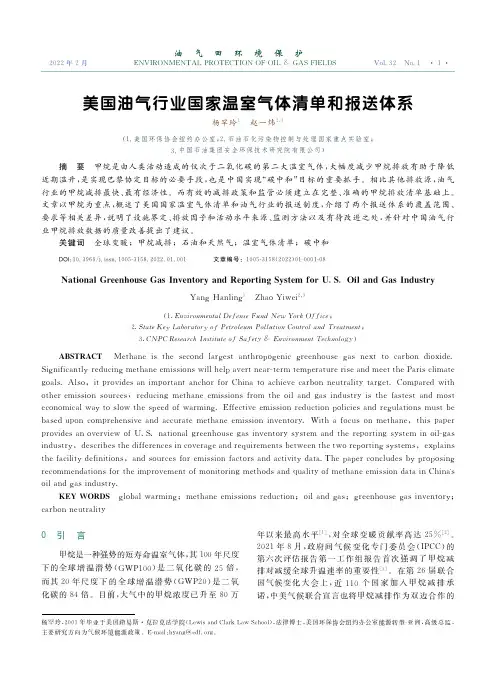
杨罕玲,2001年毕业于美国路易斯·克拉克法学院(LewisandClarkLawSchool),法律博士,美国环保协会纽约办公室能源转型 亚洲,高级总监,主要研究方向为气候环境能源政策。
E mail:hyang@edf.org。
美国油气行业国家温室气体清单和报送体系杨罕玲1 赵一炜2,3(1.美国环保协会纽约办公室;2.石油石化污染物控制与处理国家重点实验室;3.中国石油集团安全环保技术研究院有限公司)摘 要 甲烷是由人类活动造成的仅次于二氧化碳的第二大温室气体,大幅度减少甲烷排放有助于降低近期温升,是实现巴黎协定目标的必要手段,也是中国实现“碳中和”目标的重要抓手。
相比其他排放源,油气行业的甲烷减排最快、最有经济性。
而有效的减排政策和监管必须建立在完整、准确的甲烷排放清单基础上。
文章以甲烷为重点,概述了美国国家温室气体清单和油气行业的报送制度,介绍了两个报送体系的覆盖范围、要求等相关差异,说明了设施界定、排放因子和活动水平来源、监测方法以及有待改进之处,并针对中国油气行业甲烷排放数据的质量改善提出了建议。
关键词 全球变暖;甲烷减排;石油和天然气;温室气体清单;碳中和DOI:10.3969/j.issn.1005 3158.2022.01.001 文章编号:1005 3158(2022)01 0001 08犖犪狋犻狅狀犪犾犌狉犲犲狀犺狅狌狊犲犌犪狊犐狀狏犲狀狋狅狉狔犪狀犱犚犲狆狅狉狋犻狀犵犛狔狊狋犲犿犳狅狉犝.犛.犗犻犾犪狀犱犌犪狊犐狀犱狌狊狋狉狔YangHanling1 ZhaoYiwei2,3(1.犈狀狏犻狉狅狀犿犲狀狋犪犾犇犲犳犲狀狊犲犉狌狀犱犖犲狑犢狅狉犽犗犳犳犻犮犲;2.犛狋犪狋犲犓犲狔犔犪犫狅狉犪狋狅狉狔狅犳犘犲狋狉狅犾犲狌犿犘狅犾犾狌狋犻狅狀犆狅狀狋狉狅犾犪狀犱犜狉犲犪狋犿犲狀狋;3.犆犖犘犆犚犲狊犲犪狉犮犺犐狀狊狋犻狋狌狋犲狅犳犛犪犳犲狋狔牔犈狀狏犻狉狅狀犿犲狀狋犜犲犮犺狀狅犾狅犵狔)犃犅犛犜犚犃犆犜 Methaneisthesecondlargestanthropogenicgreenhousegasnexttocarbondioxide.Significantlyreducingmethaneemissionswillhelpavertnear termtemperatureriseandmeettheParisclimategoals.Also,itprovidesanimportantanchorforChinatoachievecarbonneutralitytarget.Comparedwithotheremissionsources,reducingmethaneemissionsfromtheoilandgasindustryisthefastestandmosteconomicalwaytoslowthespeedofwarming.Effectiveemissionreductionpoliciesandregulationsmustbebaseduponcomprehensiveandaccuratemethaneemissioninventory.Withafocusonmethane,thispaperprovidesanoverviewofU.S.nationalgreenhousegasinventorysystemandthereportingsysteminoil gasindustry,describesthedifferencesincoverageandrequirementsbetweenthetworeportingsystems,explainsthefacilitydefinitions,andsourcesforemissionfactorsandactivitydata.ThepaperconcludesbyproposingrecommendationsfortheimprovementofmonitoringmethodsandqualityofmethaneemissiondatainChina'soilandgasindustry.犓犈犢犠犗犚犇犛 globalwarming;methaneemissionsreduction;oilandgas;greenhousegasinventory;carbonneutrality0 引 言甲烷是一种强势的短寿命温室气体,其100年尺度下的全球增温潜势(GWP100)是二氧化碳的25倍,而其20年尺度下的全球增温潜势(GWP20)是二氧化碳的84倍。
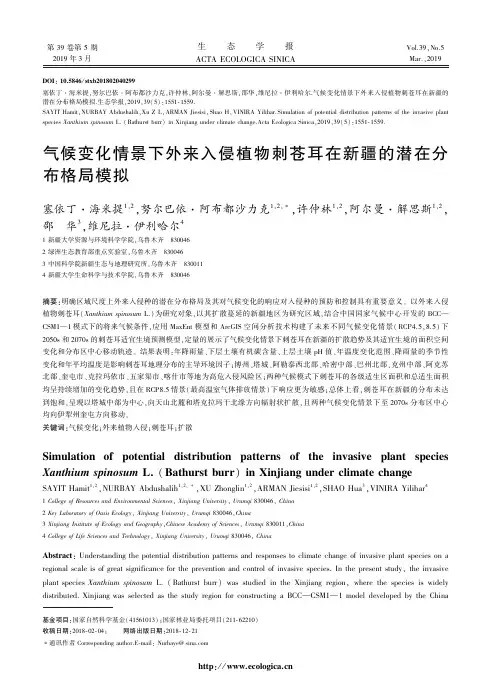
第39卷第5期2019年3月生态学报ACTAECOLOGICASINICAVol.39,No.5Mar.,2019基金项目:国家自然科学基金(41561013);国家林业局委托项目(211⁃62210)收稿日期:2018⁃02⁃04;㊀㊀网络出版日期:2018⁃12⁃21∗通讯作者Correspondingauthor.E⁃mail:Nurbaye@sina.comDOI:10.5846/stxb201802040299塞依丁㊃海米提,努尔巴依㊃阿布都沙力克,许仲林,阿尔曼㊃解思斯,邵华,维尼拉㊃伊利哈尔.气候变化情景下外来入侵植物刺苍耳在新疆的潜在分布格局模拟.生态学报,2019,39(5):1551⁃1559.SAYITHamit,NURBAYAbdushalih,XuZL,ARMANJiesisi,ShaoH,VINIRAYilihar.SimulationofpotentialdistributionpatternsoftheinvasiveplantspeciesXanthiumspinosumL.(Bathurstburr)inXinjiangunderclimatechange.ActaEcologicaSinica,2019,39(5):1551⁃1559.气候变化情景下外来入侵植物刺苍耳在新疆的潜在分布格局模拟塞依丁㊃海米提1,2,努尔巴依㊃阿布都沙力克1,2,∗,许仲林1,2,阿尔曼㊃解思斯1,2,邵㊀华3,维尼拉㊃伊利哈尔41新疆大学资源与环境科学学院,乌鲁木齐㊀8300462绿洲生态教育部重点实验室,乌鲁木齐㊀8300463中国科学院新疆生态与地理研究所,乌鲁木齐㊀8300114新疆大学生命科学与技术学院,乌鲁木齐㊀830046摘要:明确区域尺度上外来入侵种的潜在分布格局及其对气候变化的响应对入侵种的预防和控制具有重要意义㊂以外来入侵植物刺苍耳(XanthiumspinosumL.)为研究对象,以其扩散蔓延的新疆地区为研究区域,结合中国国家气候中心开发的BCC CSM1 1模式下的将来气候条件,应用MaxEnt模型和ArcGIS空间分析技术构建了未来不同气候变化情景(RCP4.5,8.5)下2050s和2070s的刺苍耳适宜生境预测模型,定量的展示了气候变化情景下刺苍耳在新疆的扩散趋势及其适宜生境的面积空间变化和分布区中心移动轨迹㊂结果表明:年降雨量㊁下层土壤有机碳含量㊁上层土壤pH值㊁年温度变化范围㊁降雨量的季节性变化和年平均温度是影响刺苍耳地理分布的主导环境因子;博州㊁塔城㊁阿勒泰西北部㊁哈密中部㊁巴州北部㊁克州中部㊁阿克苏北部㊁奎屯市㊁克拉玛依市㊁五家渠市㊁喀什市等地为高危入侵风险区;两种气候模式下刺苍耳的各级适生区面积和总适生面积均呈持续增加的变化趋势,且在RCP8.5情景(最高温室气体排放情景)下响应更为敏感;总体上看,刺苍耳在新疆的分布未达到饱和,呈现以塔城中部为中心,向天山北麓和塔克拉玛干北缘方向辐射状扩散,且两种气候变化情景下至2070s分布区中心均向伊犁州奎屯方向移动㊂关键词:气候变化;外来植物入侵;刺苍耳;扩散SimulationofpotentialdistributionpatternsoftheinvasiveplantspeciesXanthiumspinosumL.(Bathurstburr)inXinjiangunderclimatechangeSAYITHamit1,2,NURBAYAbdushalih1,2,∗,XUZhonglin1,2,ARMANJiesisi1,2,SHAOHua3,VINIRAYilihar41CollegeofResourcesandEnvironmentalSciences,XinjiangUniversity,Urumqi830046,China2KeyLaboratoryofOasisEcology,XinjiangUniversity,Urumqi830046,China3XinjiangInstituteofEcologyandGeography,ChineseAcademyofSciences,Urumqi830011,China4CollegeofLifeSciencesandTechnology,XinjiangUniversity,Urumqi830046,ChinaAbstract:Understandingthepotentialdistributionpatternsandresponsestoclimatechangeofinvasiveplantspeciesonaregionalscaleisofgreatsignificanceforthepreventionandcontrolofinvasivespecies.Inthepresentstudy,theinvasiveplantspeciesXanthiumspinosumL.(Bathurstburr)wasstudiedintheXinjiangregion,wherethespeciesiswidelydistributed.XinjiangwasselectedasthestudyregionforconstructingaBCC CSM1 1modeldevelopedbytheChina2551㊀生㊀态㊀学㊀报㊀㊀㊀39卷㊀NationalClimateCentertosimulatefutureclimateconditions.AMaxEntmodelandtheArcGISspatialanalysttoolwereusedtoconstructpredictivemodelsofsuitablehabitatsforX.spinosuminthe2050sand2070sundertwofutureclimatechangescenarios(RCP4.5and8.5).TheultimateaimwastoquantitativelydemonstratethedispersaltrendsofX.spinosuminXinjiang,variationsintheareaofsuitablehabitat,andthemovementpathofthecenterofdistribution.Theresultsindicatedthatannualprecipitation,subsoilorganiccarboncontent,topsoilpH,annualtemperaturerange,seasonalvariationsinannualprecipitation,andannualaveragetemperaturearedominantenvironmentalfactorsthataffectthegeographicaldistributionofX.spinosum.Bortala,Tacheng,NorthwestAltay,CentralHami,NorthernBayingol,CentralKizilsu,NorthernAksu,KuytunCity,KaramayCity,WujiaquCity,andKashgarCitywereidentifiedasareaswithhighinvasionrisk.TrendsofacontinuousincreaseintheareaofsuitablehabitatattherespectivelevelsandinthetotalareaofsuitablehabitatforX.spinosumwerepredictedforbothclimatescenarios,withtheresponsesbeingmoresensitiveintheRCP8.5scenario(highemissions).Ingeneral,thedistributionofX.spinosuminXinjianghasnotreachedsaturation,withthespeciesbeingradiallydispersedtowardsthenorthpiedmontofTianshanMountainsandthenorthernmarginoftheTaklamakanDesertfromthecenterofdistributionincentralTacheng.ThecenterofdistributionispredictedtomovetowardsKuituninIliPrefectureby2070underbothclimatechangescenarios.KeyWords:climatechange;alieninvasiveplant;XanthiumspinosumL.;expansion气候变化作为全球变化的一个重要方面,主要表现在温度的上升㊁降水格局的改变以及极端气候事件的增加[1⁃2]㊂在区域尺度上,气候因素会对物种的生长繁殖㊁物候㊁地理分布范围等产生诸多影响[3⁃5]㊂随着全球温室气体排放量的指数型增长,我国未来气候变暖趋势将进一步加剧,全国大部分地区的降水量会有所增加,但是西部地区降水量将会减少[6]㊂新疆属于典型的干旱半干旱地区,生态系统极为脆弱,容易遭受外来生物的入侵,面临着极大的入侵风险㊂在全球气候变化的大背景下外来入侵植物的适宜生境有可能扩大,也有可能因为气候条件超过了入侵植物的适宜范围而缩小㊂如Bourdot等[7]的模拟研究结果表明,入侵植物Nassellaneesiana在未来气候情景下的适宜生境有不同程度的减小㊂刘金雪[8]的研究结果表明,入侵植物互花米草的适宜生境在RCP4.5情景(中等温室气体排放情景)下呈扩大趋势,在RCP8.5情景(最高温室气体排放情景)下呈减小趋势㊂Roger等[9]的评估结果表明入侵植物的适宜生境在未来气候情景下的变化并无一致的规律㊂因此,制定长期有效的预防措施需要考虑外来入侵种在未来气候变化情景下的分布[10]㊂刺苍耳(XanthiumspinosumL.)是菊科苍耳属一年生草本植物,是一种入侵性极强的恶性杂草,已经在全球范围内广泛的扩散蔓延[11]㊂中国境内的刺苍耳首先在河南邯郸县发现,现已扩散至河南㊁安徽㊁辽宁㊁北京㊁内蒙古㊁宁夏㊁新疆等多个省市区,其在新疆主要分布在伊犁地区㊁昌吉市㊁石河子市㊁乌鲁木齐市等地[12⁃13]㊂刺苍耳的竞争能力和适应能力很强[14],很容易在新的环境中占据领地,与原有植物和农作物竞争光照㊁矿质营养㊁水分㊁空间等生存资源,严重影响了当地植物群落的结构和组成㊂致使入侵地的草场退化㊁农作物减产㊁原有物种灭绝和物种多样性降低[15]㊂因此,研究气候变化对外来入侵植物刺苍耳潜在分布范围及空间格局的影响对保护新疆的生物多样性有重要的意义㊂鉴于刺苍耳在新疆的分布现状㊁扩散趋势和潜在危害㊂本研究结合中国国家气候中心开发的BCC CSM1 1模式下的将来气候条件,应用MaxEnt模型和ArcGIS空间分析技术分别构建了未来不同气候变化情景下刺苍耳适宜生境预测模型,分析比较了刺苍耳适宜生境的面积空间变化及分布区中心移动轨迹,明确了影响其潜在地理分布的主导环境变量,旨在揭示全球气候变化背景下刺苍耳在新疆的扩散趋势,目的在于预防和控制外来入侵植物刺苍耳在新疆的进一步扩散蔓延,减小气候变化对新疆生物多样性的不利影响,给入侵预防和控制提供相应的决策支持㊂1㊀数据与方法1.1㊀物种分布数据来源㊀㊀刺苍耳在新疆的地理分布数据来源于国家林业局委托项目第二次全国植物资源普查新疆片区的调查工作㊂划定刺苍耳的花果期7 10月为野外考察期[16],于2015 2017年在新疆境内进行野外实地采样,调查点主要有伊宁市㊁伊宁县㊁巩留县㊁特克斯县㊁新源县㊁察布查尔县㊁霍城县㊁尼勒克县㊁博乐市㊁昌吉市㊁石河子市㊁乌鲁木齐市㊁塔城地区和阿勒泰地区,发现刺苍耳即记为 存在点(presence) ,用GPS记录经纬度和海拔,共获得92条不重复的的地理分布数据(图1)㊂图1㊀刺苍耳在新疆的地理分布Fig.1㊀DistributionofXanthiumspinosumL.inXinjiang1.2㊀环境变量的选择本文共选取生物气候因子㊁地形因子㊁土壤因子等31个环境变量㊂其中,现代(1960 1990年的均值)和未来气候情景2050s(2041 2060年的均值)和2070s(2061 2080年的均值)的19个生物气候变量均来源于Worldclim数据集(http://www.worldclim.org/)[17],该数据集分辨率为1km,由19个降水量㊁温度的极值和变化范围的变量构成,根据新疆政区图对下载的全球气候数据进行影像配准㊁裁剪和叠加㊂海拔高程数据(DEM)从美国国家航空航天局发布的全球数字高程模型(SRTMv4.1,http://datamirror.csdb.cn/)下载,空间分辨率为100m[18]㊂坡向和坡度利用ArcToolbox工具箱的表面分析工具根据DEM生成㊂土壤数据来源于南京土壤所制作的二调数据,选取了数据集中的9个土壤变量,其中以T_开头的字段表示上层土壤属性(0 30cm),以S_开头的字段表示下层土壤属性(30 100cm)㊂2050s和2070s两个未来时间段的生物气候变量来源于政府间气候变化专门委员会(IntergovernmentalPanelonClimateChange,IPCC)第5次气候评估报告发布的缩减全球气候模型数据㊂结合研究区域的地理位置,采用由中国国家气候中心基于缩减全球气候模型数据开发的BCC CSM1 1模式下的2种不同气候变化情景(RCP4.5㊁RCP8.5)数据[19]㊂RCPs(RepresentativeConcentrationPathways)情景对温度和降水等各变量的模拟和预测具有较高的准确性,且更加详细的考虑了温室气体排放量受人类应对全球气候变化所采取的各种方针策略的影响[6]㊂本文选取的RCP4.5气候情景代表未来气候变化情景下的中等温室气体排放情景,在RCP4.5情景下至2100年温室气体浓度稳定为650ˑ10-6CO2当量㊂RCP8.5气候情景代表未来气候变化情景下的最高温室气体排放情景,在RCP8.5情景下至2100年温室气体浓度高于1370ˑ10-6CO2当量[8]㊂假设未来气候条件下土壤因子不发现变化㊂在建模过程中除了要考虑变量之间存在自相关和多重线性重复等问题外,还需要考虑模型的维度和复杂程度,这些因素均会对模型的转移能力产生影响㊂因此,本研究参考Worthington[20]㊁张天蛟[21]等的方法对环境变量进行了筛选,具体方法为在R语言中加载cor函数包,分别计算生物气候因子和土壤因子的spearman相关系数[22],并细致考虑变量的生态学意义,选用相关系数<0.75的环境因子,对于相关系数>0.75的环境因子进行单因子建模,运行刀割法测定其对模型预测的贡献率大小,以此剔除对物种分布贡献率较小的环境因子,最终筛选出17个环境变量参与建模(表1)㊂1.3㊀矢量图及模型来源本文所用的新疆政区矢量图,来源于新疆维吾尔自治区测绘地理信息局的标准地图下载服务区,地址为http://www.xjch.gov.cn/wsfw/bzdt/bzdtxz/㊂MaxEnt模型是由S.J.Philliips于2004年构建的用于预测物种分3551㊀5期㊀㊀㊀塞依丁㊃海米提㊀等:气候变化情景下外来入侵植物刺苍耳在新疆的潜在分布格局模拟㊀4551㊀生㊀态㊀学㊀报㊀㊀㊀39卷㊀布的技术方法[23],本研究所使用的MaxEnt软件为3.3.3k版[24]㊂ArcGIS空间技术平台是美国Esri公司研发的一套完整的GIS产品,本研究所使用的ArcGIS软件版本为10.2.2版[25⁃26]㊂表1㊀17个参与建模的环境变量及其贡献率Table1㊀17environmentalvariablesusedformodelingandtheircontributionrates变量名称Codeofvariables描述Namesofvariables贡献率PermutationimportancePercentcontribution/%重要性Bio1年平均温度Meanannualtemperature4.827Bio3等温线Isotherm0.72.8Bio7年温度变化范围Annualtemperaturerange9.10.8Bio12年降雨量Annualrainfall49.159.9Bio15降雨量的季节性变化Seasonalchangesinrainfall7.50.2T_texture土壤质地Soiltexture0.50.1S_cec_soil下层土土壤的阳离子交换能力CECofundersoil3.40T_cec_soil上层土土壤的阳离子交换能力CECoftopsoil0.20.5S_sand下层土沙含量Lowersoilsedimentcontent0.70.2T_sand上层土沙含量Uppersoilsedimentcontent0.10.1S_ph_h2o下层土pHpHofundersoil00T_ph_h2o上层土pHpHoftopsoil9.93.3S_oc下层土有机碳含量Organiccarboncontentofundersoil10.40.4T_oc上层土有机碳含量Organiccarboncontentoftopsoil2.12.2Alt海拔Altitude0.21.1Aspect坡向Aspect1.31Slope坡度Slope0.20.31.4㊀MaxEnt模型构建及数据处理将刺苍耳地理分布数据和17个环境变量导入MaxEnt,随机选取75%的刺苍耳分布点作为训练集,剩余25%的刺苍耳分布点作为测试集[27],运行刀割法测定各环境变量在影响刺苍耳生长适宜度中所占的权重,并创建各环境变量的单因子响应曲线,模型的其余参数均选择默认值㊂本研究用受试者操作特征曲线(ReceiverOperatingCharacteristicCurve,ROC曲线)下面积值,即AUC值(AreaUnderCurve,AUC)为判据评价模型的模拟结果[28]㊂不同的AUC值代表不同预测效果(表2)[29]㊂将模型输出的栅格图层导入ArcGIS,采用 10percentiletrainingpersencelogisticthreshold 进行重分类,并根据专家经验法将刺苍耳的适宜生境划分成4个等级:0 0.40为非适应区,0.40 0.60为低适生区,0.60 0.80为中适生区,0.80 1.00为高适生区[30]㊂再运用ArcGIS的SDM工具箱和统计工具Zonal计算4类分区的面积和面积空间变化,通过适宜区域几何面积化确定分布区中心移动轨迹,分析比较刺苍耳在不同气候变化情景下的潜在分布范围和格局㊂表2㊀AUC值取值范围及其与模型准确性的关系2㊀结果与分析2.1㊀MaxEnt模型预测结果检测及贡献率评估㊀㊀本研究的预测结果显示训练集的AUC值为0.986,测试集的AUC值为0.957(图2),表明MaxEnt模型的预测结果可靠,刺苍耳的实际分布范围与模型预测的地理分布范围具有较高的一致性,预测结果可用于刺苍耳的适宜生境区划[31]㊂在模型中运行刀割法(Jackknifetest),运行结果显示出各环境变量对刺苍耳适宜生境预测的相对贡献率(表1),Bio12年降雨量的贡献率最高(49.1%),是影响刺苍耳分布的决定因子;S_oc下层土有机碳含量的贡献率为10.4%,仅次于年降雨量,是影响刺苍耳分布的次要因子;其次,T_ph_h2o上层土pH(9.9%)㊁Bio7年温度变化范围(9.1%)㊁Bio15降雨量的季节性变化(7.5%)和Bio1年平均温度(4.8%)的贡献率也均超过了4%,以上6个因子的贡献率总和高达90.8%,是影响刺苍耳地理分布的主导环境因子㊂图2㊀刺苍耳潜在分布预测结果的ROC曲线验证Fig.2㊀ROCCurveandAUCvaluesoftheMaxEntmodel㊀ROC:受试者操作特征,ReceiverOperatingCharacteristic;AUC:曲线下面积值,AreaUnderCurve2.2㊀刺苍耳在现代及未来气候变化情景下的潜在分布预测由预测结果(图3)和统计分析可知(表3),刺苍耳在现代气候及未来气候情景下的适生区主要分布在天山以北,且随着气候变化的加剧,刺苍耳的适宜生境会扩散至天山以南的区域㊂总体上看,刺苍耳在新疆的分布未达到饱和且即将进入指数型的增长和扩散阶段㊂现代气候情景下刺苍耳在新疆的适宜生境主要包括伊犁中部和西北部㊁博州中部㊁塔城西北部㊁昌吉中部㊁石河子市中部和乌鲁木齐市北部,总适生面积为3.33ˑ104km2㊂RCP4.5情景(中等温室气体排放情景)下刺苍耳的适宜生境主要包括伊犁州全境㊁博州全境㊁塔城全境㊁奎屯市㊁克拉玛依市㊁石河子市㊁五家渠市㊁乌鲁木齐市㊁昌吉州中部和西部㊁阿勒泰西北部㊁哈密中部㊁巴州北部㊁阿克苏北部㊁克州中部和喀什市,2050s和2070s的总适生面积分别为12.85ˑ104km2和16.18ˑ104km2㊂RCP8.5情景(最高温室气体排放情景)下刺苍耳的适宜生境在RCP4.5气候情景下的适宜生境基础上进一步向四周扩张,且高适生区的扩增尤为显著,2050s和2070s的总适生面积分别为17.46ˑ104km2和21.50ˑ104km2㊂两种气候模式下各级适生区面积和总适生面积均呈持续增加的变化趋势,且在RCP8.5情景(最高温室气体排放情景)下响应更为敏感㊂表3㊀不同气候变化情景下刺苍耳在新疆的适生区面积/ˑ104km2Table3㊀SuitableareaofXanthiumspinosumL.inXinjiangunderchangingclimatescenarios气候变化情景Climatechangescenario高适生区面积Highlysuitablearea中适生区面积Suitablearea低适生区面积Lowsuitablearea非适应区面积Unsuitablearea总适生面积(比例)Totalsuitablearea(percentage)现代Current1.172.168.51151.583.33(2.04%)RCP4.5⁃2050s8.114.7415.37135.212.85(7.86%)RCP4.5⁃2070s10.096.0915.69131.5516.18(9.90%)RCP8.5⁃2050s11.046.4213.54132.4217.46(10.68%)RCP8.5⁃2070s15.166.3414.26127.6521.50(13.16%)2.3㊀气候变化情景下刺苍耳适宜生境的面积空间变化及分布区中心移动轨迹当前至RCP4.5中等温室气体排放情景下,至2050s刺苍耳在新疆的适宜生境增加16.38ˑ104km2(图4),5551㊀5期㊀㊀㊀塞依丁㊃海米提㊀等:气候变化情景下外来入侵植物刺苍耳在新疆的潜在分布格局模拟㊀图3㊀不同气候变化情景下刺苍耳在新疆的适生区分布Fig.3㊀SuitabledistributionforXanthiumspinosumL.inXinjiangunderchangingclimatescenarios增加面积是当前适生总面积的4.92倍,至2070s刺苍耳在新疆的适宜生境增加20.03ˑ104km2,增加面积是当前适生总面积的6.02倍㊂分布区中心由塔城中部(现代)经塔城南部(2050s)向伊犁州奎屯(2070s)方向移动(图5)㊂当前至RCP8.5最高温室气体排放情景下,至2050s刺苍耳在新疆的适宜生境增加19.16ˑ104km2,增加面积是当前适生总面积的5.75倍,至2070s刺苍耳在新疆的适宜生境增加23.92ˑ104km2,增加面积是当前适生总面积的7.18倍㊂分布区中心由塔城中部(现代)经克拉玛依市(2050s)向伊犁州奎屯(2070s)方向移动㊂说明在未来气候情景下,刺苍耳在新疆的适生分布区范围逐渐扩大,面积空间变化明显,呈现以塔城中部为中心,向天山北麓和塔克拉玛干北缘方向辐射状扩散,且两种气候变化情景下至2070s分布区中心均向伊犁州奎屯方向移动㊂3㊀讨论与结论制定长期有效的预防和控制措施需要考虑外来入侵种在未来气候变化情景下的分布,本研究结合中国国家气候中心开发的BCC CSM1 1模式下的将来气候条件,利用最大熵模型MaxEnt和ArcGIS空间分析技术对刺苍耳的适宜生境进行了全疆范围的模拟预测,ROC曲线测评结果可靠,预测结果与刺苍耳实际分布区域的相符度较高㊂原因在于本研究通过spearman相关系数对参与建模的环境因子进行了筛选,有效的降低了6551㊀生㊀态㊀学㊀报㊀㊀㊀39卷㊀图4㊀未来气候情景对比现代气候情景下刺苍耳适宜生境的变化Fig.4㊀ChangesofsuitablehabitatsofXanthiumspinosumL.underfutureclimatescenariosversusmodernclimatescenarios图5㊀不同气候情景下刺苍耳分布区中心与其移动轨迹变化㊀Fig.5㊀ChangesincenterofdistributionareaofXanthiumspinosumL.anditsmovingtrajectoryunderdifferentclimatechangescenarios模型的维度和复杂程度㊂当前气候情景下刺苍耳总适生面积比例为2.04%,在RCP4.5㊁RCP8.5两种情景下至2050s,预测的总适生面积比例为7.86%㊁10.68%,适宜生境的增加面积分别是当前适生总面积的4.92和5.75倍㊂至2070s,预测的总适生面积比例为9.90%㊁13.16%,适宜生境的增加面积分别是当前适生总面积的6.02和7.18倍㊂说明在未来气候变化情景下,刺苍耳在新疆的种群数量和分布范围可能较当前会有一个指数型的增长和扩张,爆发成灾的可能性很大,入侵预防和控制任务更为艰巨㊂除已知分布区外,气候变化情景下博州㊁塔城㊁阿勒泰西北部㊁哈密中部㊁巴州北部㊁克州中部㊁阿克苏北部㊁奎屯市㊁克拉玛依市㊁五家渠市㊁喀什市等地的刺苍耳生境适宜度较高,具有极高的入侵风险㊂总体上看,刺苍耳在新疆的分布未达到饱,呈现以塔城中部为中心,向天山北麓和塔克拉玛干北缘方向辐射状扩散㊂本文参考Yue等[32]的计算方法,确定刺苍耳在现代气候及未来气候情景下的适宜生境中心均位于北疆地区,原因可能有以下两点:(1)天山北麓属于温带大陆性干旱半干旱气候,全年降雨量为150 200mm,塔克拉玛干南缘属于暖温带大陆性干旱气候,全年降雨量为25 100mm[33],而年降雨量是影响刺苍耳分布的决定因子,从单因子响应曲线看,年降雨量的范围在13 607mm之间,且刺苍耳的生长适宜度随着年降雨量的增加而增大;(2)土壤因子在影响刺苍耳生长适宜度中所占的权重较高(27.1%),且下层土有机碳含7551㊀5期㊀㊀㊀塞依丁㊃海米提㊀等:气候变化情景下外来入侵植物刺苍耳在新疆的潜在分布格局模拟㊀8551㊀生㊀态㊀学㊀报㊀㊀㊀39卷㊀量是影响刺苍耳分布的次要因子,而朱敏等[34]的研究结果表明天山北麓的土壤养分状况要优于塔克拉玛干北缘,由此可见降水量和土壤养分的差异使刺苍耳在北疆获得了更为广阔的适宜生境㊂但随着气候变化的加剧,刺苍耳的适宜生境会扩张至塔克拉玛干北缘,这可能是因为南疆的冬季气候相对温暖,更利于刺苍耳种子的越冬,这与李杰等[35]得出的结论一致㊂而目前尚未在南疆地区出现刺苍耳的原因可能是天山山脉的阻隔作用,但随着气候变化的加剧,丝绸之路经济带战略的实施,南北疆交通道路的建设和口岸贸易的发展,天山山脉的阻隔作用会有很大程度的减弱,因此在预防措施中不能只考虑北疆部分,南疆也需重点考虑㊂在野外调查过程中发现,伊犁㊁博州等刺苍耳入侵区域的省道和县级公路的两侧已经基本被其占据,且同属菊科苍耳属的意大利苍耳(XanthiumitalicumMoretti),菊科假苍耳属的假苍耳(IvaxanthifoliaN.)等入侵物种也在北疆迅速的扩散蔓延,伊犁㊁昌吉等地还呈现刺苍耳和意大利苍耳交替分布的现象㊂此外,刺苍耳的果实具有刺,牛羊不食,很容易黏着在牛羊等牲畜的皮毛上,再由其携带进行远距离的传播扩散,牧民和地方管理部门对其危害程度的认识也不高,这些现象极大的威胁了入侵地的生物多样性和景观格局㊂全球入侵物种计划(GlobalInvasiveSpeciesProgram,GISP)的主席Waage提出:对外来物种入侵,预防比控制其暴发更为可行,也更为经济[36]㊂因此,鉴于刺苍耳的扩散趋势和野外调查的实际结果,作者提出以下几点防治措施:(1)检疫部门应该将工作概念由过去局限在农产品检验扩大到所有的植物产品,并加强对口岸动物皮毛的检疫;(2)应该针对刺苍耳的适生区建立两条隔离监测带,第一条建立在克拉玛依市,预警和控制刺苍耳继续向天山以北的方向扩散㊂第二条建立在巴州的和硕县和阿克苏的拜城县,预防刺苍耳扩散至天山以南的区域,并且对隔离监测带进行系统的监测和周期评估;(3)从全疆的层面建立入侵物种数据库,为林业部门㊁环保部门和行政部门提供准确全面的生物入侵信息;(4)加强在牧区和草场的宣传力度,出台相应的政策法规,让牧民和草场管理者能及时的发现刺苍耳并汇报上级部门㊂本研究定量的展示了气候变化情景下外来入侵种刺苍耳在新疆扩散趋势,为全球气候变化对干旱区半干旱区生物多样性的影响,尤其是对入侵种刺苍耳的影响研究,提供了科学依据㊂然而,本研究也存在着一定的局限性和不足之处,原因在于研究中仅考虑了生物气候㊁地形㊁土壤等环境因子,而未考虑植物的生命周期㊁遗传特性㊁繁殖能力㊁人类活动㊁光照㊁河流等其他因素㊂且预测是以当前的刺苍耳分布点为基础进行的,未考虑未来分布点的实际变化,不可避免的造成了一定的误差㊂因此,在今后的研究中需要进一步考虑环境变量的选取,并着重追溯刺苍耳的入侵历史,分阶段的验证刺苍耳分布点的实际变化㊂参考文献(References):[1]㊀EdwardsPN.AVastMachine:ComputerModels,ClimateData,andthePoliticsofGlobalWarming.Cambridge:TheMITPress,2010.[2]㊀李丽鹤.气候变化与人类活动对入侵植物潜在分布的影响及风险区识别 以云南省为例[D].南京:南京师范大学,2017.[3]㊀PoundsJA,BustamanteMR,ColomaLA,ConsuegraJA,FogdenMPL,FosterPN,LaMarcaE,MastersKL,Merino⁃ViteriA,PuschendorfR,RonSR,Sánchez⁃AzofeifaGA,StillCJ,YoungBE.Widespreadamphibianextinctionsfromepidemicdiseasedrivenbyglobalwarming.Nature,2006,439(7073):161⁃167.[4]㊀KozakKH,GrahamCH,WiensJJ.IntegratingGIS⁃basedenvironmentaldataintoevolutionarybiology.TrendsinEcology&Evolution,2008,23(3):141⁃148.[5]㊀王茹琳,李庆,何仕松,刘原.中华猕猴桃在中国潜在分布及其对气候变化响应的研究.中国生态农业学报,2018,26(1):27⁃37.[6]㊀唐继洪,程云霞,罗礼智,张蕾,江幸福.基于Maxent模型的不同气候变化情景下我国草地螟越冬区预测.生态学报,2017,37(14):4852⁃4863.[7]㊀BourdôtGW,LamoureauxSL,WattMS,ManningLK,KriticosDJ.ThepotentialglobaldistributionoftheinvasiveweedNassellaneesianaundercurrentandfutureclimates.BiologicalInvasions,2012,14(8):1545⁃1556.[8]㊀刘金雪.气候变化对外来入侵植物互花米草潜在分布区的影响[D].南京:南京师范大学,2016.[9]㊀RogerE,DuursmaDE,DowneyPO,GallagherRV,HughesL,SteelJ,JohnsonSB,LeishmanMR.Atooltoassesspotentialforalienplantestablishmentandexpansionunderclimatechange.JournalofEnvironmentalManagement,2015,159:121⁃127.[10]㊀张颖.基于GIS的生态位模型预测源自北美的菊科入侵物种的潜在适生区[D].南京:南京农业大学,2011.[11]㊀梁巧玲,刘忠权,陆平,陈卫民.刺苍耳在新疆伊犁河谷的分布及生长发育特性.杂草学报,2017,35(1):25⁃29.[12]㊀宋珍珍,谭敦炎,周桂玲.入侵植物刺苍耳在新疆的分布及其群落特征.西北植物学报,2012,32(7):1448⁃1453.[13]㊀杜珍珠,徐文斌,阎平,王少山,郭一敏.新疆苍耳属3种外来入侵新植物.新疆农业科学,2012,49(5):879⁃886.[14]㊀袁着耕,刘影,邵华,赵金雨,赵玉,胡云霞.不同生长期入侵植物刺苍耳的化感作用.生态科学,2017,36(6):107⁃113.[15]㊀宋珍珍,刘同业,谭敦炎,周桂玲.两种入侵植物对新疆当地物种多样性的影响.新疆农业科学,2012,49(11):2120⁃2126.[16]㊀周明冬,秦晓辉.有害入侵生物刺苍耳的危害与控制.新疆农业科技,2014,(3):47⁃48.[17]㊀张殷波,高晨虹,秦浩.山西翅果油树的适生区预测及其对气候变化的响应.应用生态学报,2018,29(4):1156⁃1162.[18]㊀刘艳,阿提古丽㊃毛拉,沙毕热木㊃斯热义力,买买提明㊃苏来曼.气候变化下耐旱藓类连轴藓属在新疆的分布模拟.西北植物学报,2017,37(9):1881⁃1887.[19]㊀应凌霄,刘晔,陈绍田,沈泽昊.气候变化情景下基于最大熵模型的中国西南地区清香木潜在分布格局模拟.生物多样性,2016,24(4):453⁃461.[20]㊀WorthingtonTA,ZhangTJ,LogueDR,MittelstetAR,BrewerSK.Landscapeandflowmetricsaffectingthedistributionofafederally⁃threatenedfish:improvingmanagement,modelfit,andmodeltransferability.EcologicalModelling,2016,342:1⁃18.[21]㊀张天蛟,刘刚.提高生态位模型时间转移能力的方法研究.中国农业大学学报,2017,22(2):98⁃105.[22]㊀YangXQ,KushwahaSPS,SaranS,XuJC,RoyPS.Maxentmodelingforpredictingthepotentialdistributionofmedicinalplant,JusticiaadhatodaL.inLesserHimalayanfoothills.EcologicalEngineering,2013,51:83⁃87.[23]㊀PhillipsSJ,DudíkM.ModelingofspeciesdistributionswithMaxent:newextensionsandacomprehensiveevaluation.Ecography,2008,31(2):161⁃175.[24]㊀PadaliaH,SrivastavaV,KushwahaSPS.Modelingpotentialinvasionrangeofalieninvasivespecies,Hyptissuaveolens(L.)Poit.inIndia:comparisonofMaxEntandGARP.EcologicalInformatics,2014,22:36⁃43.[25]㊀VinodPN,ChandramouliPN,KochM.EstimationofnitrateleachingingroundwaterinanagriculturallyusedareainthestateKarnataka,India,usingexistingModelandGIS.AquaticProcedia,2015,4:1047⁃1053.[26]㊀AndersonRP,RazaA.TheeffectoftheextentofthestudyregiononGISmodelsofspeciesgeographicdistributionsandestimatesofnicheevolution:preliminarytestswithmontanerodents(genusNephelomys)inVenezuela.JournalofBiogeography,2010,37(7):1378⁃1393.[27]㊀吴庆明,王磊,朱瑞萍,杨宇博,金洪阳,邹红菲.基于MAXENT模型的丹顶鹤营巢生境适宜性分析 以扎龙保护区为例.生态学报,2016,36(12):3758⁃3764.[28]㊀王茹琳,李庆,封传红,石朝鹏.基于MaxEnt的西藏飞蝗在中国的适生区预测.生态学报,2017,37(24):8556⁃8566.[29]㊀王亚领,李浩,杨旋,郭彦龙,李维德.基于MaxEnt模型和不同气候变化情景的单叶蔓荆潜在地理分布预测.草业学报,2017,26(7):1⁃10.[30]㊀李丽鹤,刘会玉,林振山,贾俊鹤,刘翔.基于MAXENT和ZONATION的加拿大一枝黄花入侵重点监控区确定.生态学报,2017,37(9):3124⁃3132.[31]㊀吴显坤,南程慧,汤庚国,李垚,毛丽君,张志成.气候变化对浙江楠潜在分布范围及空间格局的影响.南京林业大学学报:自然科学版,2016,40(6):85⁃91.[32]㊀YueTX,FanZM,ChenCF,SunXF,LiBL.Surfacemodellingofglobalterrestrialecosystemsunderthreeclimatechangescenarios.EcologicalModelling,2011,222(14):2342⁃2361.[33]㊀王文静,延军平,刘永林.新疆旱涝气候的南北差异性分析.干旱区研究,2016,33(3):609⁃618.[34]㊀朱敏,梁智,徐万里,周勃,丁峰.新疆绿洲棉田土壤养分时空分布特点.新疆农业科学,2009,46(5):1076⁃1081.[35]㊀李杰,马淼.新疆外来入侵植物意大利苍耳和刺苍耳种子的越冬性能.生态学报,2017,37(21):7181⁃7186.[36]㊀WaageJK,ReaserJK.Aglobalstrategytodefeatinvasivespecies.Science,2001,292(5521):1486.9551㊀5期㊀㊀㊀塞依丁㊃海米提㊀等:气候变化情景下外来入侵植物刺苍耳在新疆的潜在分布格局模拟㊀。
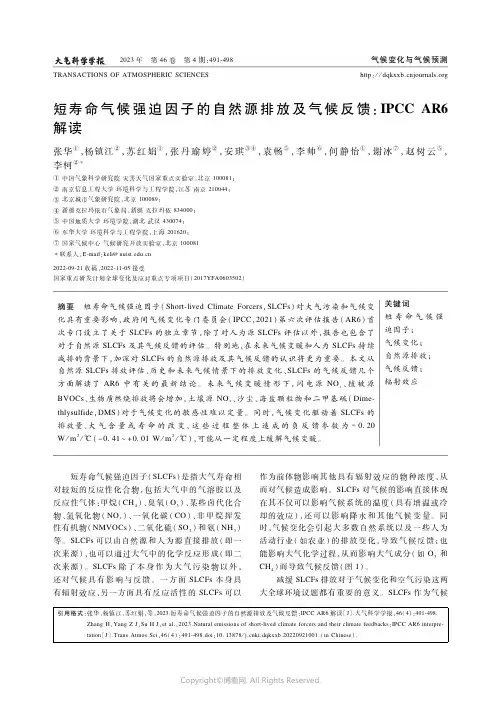
Progress in Physical Geography30, 6 (2006) pp. 1–27© 2006 SAGE Publications10.1177/0309133306071957Methods and uncertainties in bioclimaticenvelope modelling under climate change
Risto K. Heikkinen,1* Miska Luoto,1
Miguel B. Araújo,2,3Raimo Virkkala,1
Wilfried Thuiller3,4and Martin T. Sykes5
1Finnish Environment Institute, Research Department, Research Programmefor Biodiversity, PO Box 140, FIN-00251 Helsinki, Finland2Department of Biodiversity and Evolutionary Biology, National Museum ofNatural Sciences, CSIC, Madrid, Spain3Macroecology and Conservation Unit, University of Évora, Portugal4Laboratoire d’Ecologie Alpine, UMR-CNRS 5553, Université Joseph Fourier,BP 53, 38041 Grenoble Cedex 9, France5Geobiosphere Science Centre, Department of Physical Geography andEcosystems Analysis, Lund University, Sweden
Abstract:Potential impacts of projected climate change on biodiversity are often assessed usingsingle-species bioclimatic ‘envelope’models. Such models are a special case of species distributionmodels in which the current geographical distribution of species is related to climatic variables soto enable projections of distributions under future climate change scenarios. This work reviews anumber of critical methodological issues that may lead to uncertainty in predictions frombioclimatic modelling. Particular attention is paid to recent developments of bioclimatic modellingthat address some of these issues as well as to the topics where more progress needs to be made.Developing and applying bioclimatic models in a informative way requires good understanding ofa wide range of methodologies, including the choice of modelling technique, model validation,collinearity, autocorrelation, biased sampling of explanatory variables, scaling and impacts of non-climatic factors. A key challenge for future research is integrating factors such as land cover, directCO2effects, biotic interactions and dispersal mechanisms into species-climate models. We
conclude that, although bioclimatic envelope models have a number of important advantages, theyneed to be applied only when users of models have a thorough understanding of their limitationsand uncertainties.
Key words:bioclimatic model, climate change, land cover, model performance, modellingmethods, niche properties, scale, species distribution model, species geography, uncertainty,validation.
*Author for correspondence. Email: risto.heikkinen@ymparisto.fi2Methods and uncertainties in bioclimatic envelope modellingIIntroductionSeveral studies and meta-analyses have indi-cated that recent climatic change has alreadyaffected species’geographical distributionsand the persistence of populations (Parmesan,1996; Walther etal., 2002; Moore, 2003;Parmesan and Yohe, 2003). Furthermore, pro-jected climate changes are likely to have aneven greater impact on biota (Berry etal.,2002; Hill etal., 2003; Thomas etal., 2004;Thuiller etal., 2005b). There are many differ-ent methodological approaches available forexamining the potential effects of climatechange on biodiversity, ranging from dynamicecosystem and biogeochemistry models (eg,Woodward and Beerling, 1997; Peng, 2000)and spatially explicit mechanistic models forsingle species range shifts (eg, Hill etal., 2001)to physiologically based (eg, Sykes etal., 1996;Walther etal., 2005) and correlative biocli-matic envelope models (eg, Box etal., 1993;Huntley etal., 1995; Iverson and Prasad,1998; 2001; 2002; Pearson etal., 2002; 2004:Thuiller, 2003; Thuiller etal., 2005b). Thispaper concentrates on the latter group –statistical bioclimatic envelope models – whichare among the most popular approaches tosimulate species-climate change impacts.Statistical bioclimatic modelling techniquesaim at defining, for any chosen species, theclimate ‘envelope’that best describes thelimits to its spatial range by correlating thecurrent species distributions with selectedclimate variables (Beaumont and Hughes,2002; Berry etal., 2002; Pearson andDawson, 2003; Thuiller, 2003; Huntley etal.,2004). Assessments of future species’biogeo-graphical ranges are developed by applyingthe models based on the climate variablesthat best describe the current equilibrium dis-tributions to simulate future distributionsunder selected climate change scenarios(Bakkenes etal., 2002; Peterson etal., 2002a;2002b; 2004; Peterson, 2003; Thuiller, 2003;Pearson etal., 2004; Thomas etal., 2004;Thuiller etal., 2004b; 2005b).The validity of bioclimatic envelope mod-elling approaches has been questioned on thegrounds that many factors other than climatecan significantly influence species distribu-tions and the rate of distribution changes(Hampe, 2004), especially in a simulations ofthe future. Huntley etal.(1989) (see alsoHuntley, 1998, and references therein)showed that in the Holocene the approachusing climate alone did predict distributionseven though this distribution included otheraspects such as biotic interactions (cf. Davisetal., 1998; Beaumont and Hughes, 2002). Inthe future, however, extensive habitatfragmentation and species dispersallimitations (Iverson and Prasad, 2002), andimpacts of rising atmospheric CO2(Woodward and Beerling, 1997; Iverson and